Inside NASA's 5-month fight to save the Voyager 1 mission in interstellar space

After working for five months to re-establish communication with the farthest-flung human-made object in existence, NASA announced this week that the Voyager 1 probe had finally phoned home.
For the engineers and scientists who work on NASA’s longest-operating mission in space, it was a moment of joy and intense relief.
“That Saturday morning, we all came in, we’re sitting around boxes of doughnuts and waiting for the data to come back from Voyager,” said Linda Spilker, the project scientist for the Voyager 1 mission at NASA’s Jet Propulsion Laboratory in Pasadena, California. “We knew exactly what time it was going to happen, and it got really quiet and everybody just sat there and they’re looking at the screen.”
When at long last the spacecraft returned the agency’s call, Spilker said the room erupted in celebration.
“There were cheers, people raising their hands,” she said. “And a sense of relief, too — that OK, after all this hard work and going from barely being able to have a signal coming from Voyager to being in communication again, that was a tremendous relief and a great feeling.”

The problem with Voyager 1 was first detected in November . At the time, NASA said it was still in contact with the spacecraft and could see that it was receiving signals from Earth. But what was being relayed back to mission controllers — including science data and information about the health of the probe and its various systems — was garbled and unreadable.
That kicked off a monthslong push to identify what had gone wrong and try to save the Voyager 1 mission.
Spilker said she and her colleagues stayed hopeful and optimistic, but the team faced enormous challenges. For one, engineers were trying to troubleshoot a spacecraft traveling in interstellar space , more than 15 billion miles away — the ultimate long-distance call.
“With Voyager 1, it takes 22 1/2 hours to get the signal up and 22 1/2 hours to get the signal back, so we’d get the commands ready, send them up, and then like two days later, you’d get the answer if it had worked or not,” Spilker said.

The team eventually determined that the issue stemmed from one of the spacecraft’s three onboard computers. Spilker said a hardware failure, perhaps as a result of age or because it was hit by radiation, likely messed up a small section of code in the memory of the computer. The glitch meant Voyager 1 was unable to send coherent updates about its health and science observations.
NASA engineers determined that they would not be able to repair the chip where the mangled software is stored. And the bad code was also too large for Voyager 1's computer to store both it and any newly uploaded instructions. Because the technology aboard Voyager 1 dates back to the 1960s and 1970s, the computer’s memory pales in comparison to any modern smartphone. Spilker said it’s roughly equivalent to the amount of memory in an electronic car key.
The team found a workaround, however: They could divide up the code into smaller parts and store them in different areas of the computer’s memory. Then, they could reprogram the section that needed fixing while ensuring that the entire system still worked cohesively.
That was a feat, because the longevity of the Voyager mission means there are no working test beds or simulators here on Earth to test the new bits of code before they are sent to the spacecraft.
“There were three different people looking through line by line of the patch of the code we were going to send up, looking for anything that they had missed,” Spilker said. “And so it was sort of an eyes-only check of the software that we sent up.”
The hard work paid off.
NASA reported the happy development Monday, writing in a post on X : “Sounding a little more like yourself, #Voyager1.” The spacecraft’s own social media account responded , saying, “Hi, it’s me.”
So far, the team has determined that Voyager 1 is healthy and operating normally. Spilker said the probe’s scientific instruments are on and appear to be working, but it will take some time for Voyager 1 to resume sending back science data.
Voyager 1 and its twin, the Voyager 2 probe, each launched in 1977 on missions to study the outer solar system. As it sped through the cosmos, Voyager 1 flew by Jupiter and Saturn, studying the planets’ moons up close and snapping images along the way.
Voyager 2, which is 12.6 billion miles away, had close encounters with Jupiter, Saturn, Uranus and Neptune and continues to operate as normal.
In 2012, Voyager 1 ventured beyond the solar system , becoming the first human-made object to enter interstellar space, or the space between stars. Voyager 2 followed suit in 2018.
Spilker, who first began working on the Voyager missions when she graduated college in 1977, said the missions could last into the 2030s. Eventually, though, the probes will run out of power or their components will simply be too old to continue operating.
Spilker said it will be tough to finally close out the missions someday, but Voyager 1 and 2 will live on as “our silent ambassadors.”
Both probes carry time capsules with them — messages on gold-plated copper disks that are collectively known as The Golden Record . The disks contain images and sounds that represent life on Earth and humanity’s culture, including snippets of music, animal sounds, laughter and recorded greetings in different languages. The idea is for the probes to carry the messages until they are possibly found by spacefarers in the distant future.
“Maybe in 40,000 years or so, they will be getting relatively close to another star,” Spilker said, “and they could be found at that point.”
Denise Chow is a reporter for NBC News Science focused on general science and climate change.
- International edition
- Australia edition
- Europe edition
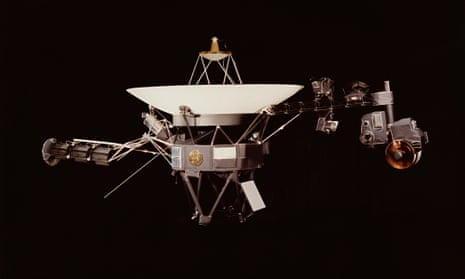

40 years and counting: the team behind Voyager’s space odyssey
In 1977, Voyager 1 and 2 started their one-way journey across our galaxy, travelling a million miles a day. Jonathan Margolis meets the dedicated team keeping the craft moving
O n a chilly March morning, Steve Howard, aged 65, is at work in his office on the northern edge of Pasadena, California. Two computer screens are squeezed on to his corner desk along with family photos, a tissue box and tins of Altoids Curiously Strong Peppermints. The office is in a quiet business park by a workaday main road. Next to it is a McDonald’s, where people linger for hours over a $1 coffee, seemingly to keep warm. Over the road there’s a scruffier burger joint, Jim’s, with an M missing from its sign – and, visible from Howard’s window, a landscaping supplies yard.
If the few people walking by on West Woodbury Road, Altadena, or popping into the landscaping place for some patio paving slabs were to peer into Howard’s office, they might guess, seeing the graph-covered twin screens and a third PC at the other end of the desk, that he was, perhaps, a financial adviser or a day trader. But what Steve Howard is actually doing makes this very ordinary all-American scene quite extraordinary.
Howard is a Nasa mission controller. He is sending instructions to a probe in interstellar space, 12 billion miles from Earth, beyond Pluto and escaping our Solar System at 1 million miles a day. The 815kg craft, Voyager 1 , is one of two identical machines that for many years now have been the furthest human-made objects from Earth. Howard’s computer code takes 17 hours at the speed of light to reach Voyager 1, the furthest travelled. Voyager 2, which is leaving the solar system in a different direction, is 3bn miles closer. The responses, from transmitters on the twin probes running 23 watts of power – have the power of a billionth of a billionth of a watt by the time they reach Earth.
“So here, see, I have Voyager 1’s status and information up, at least as it was 17 hours ago,” Howard explains. “Right now I’m connected to our Canberra station, and these are seven commands, set to radiate one every five minutes starting 30 minutes from now. They’re to verify that the spacecraft can receive and reset its timer. Such is the speed of light, I will not get confirmation that all is OK until late tomorrow night, but it will have entailed a 25bn-mile round trip, so that’s not too bad.”
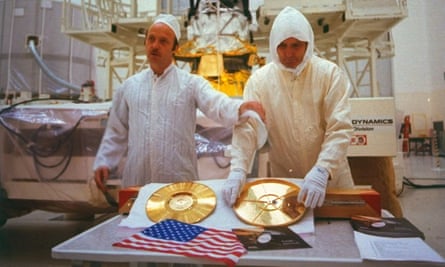
It is no hyperbole to say, then, that the man tapping away at his keyboard on the office park next to McDonald’s is a key figure in the greatest-ever feat of human exploration. There was nothing like the Voyager 1 and 2 missions to the outer planets before they launched in 1977, and although three outer planet probes launched last decade are still on mission, no new ventures into deep space are planned.
Space exploration tends to be more inward looking today than in the so-called Space Age. The famous Curiosity rover is of course still working wonders on Mars, but almost all the US’s coming spacecraft will be restricted to studying our own planet, with special attention to environmental issues. The Voyagers and the people like Howard who still work on them full-time – having, in many cases, done so their entire adult life – are from a different era, when budgets were unrestrained, audaciousness (and showing off to the Soviets) was in vogue and the environment was a concern only for hippies.
Voyager’s spindly limbed, Transit-van-sized machines have been travelling at around 37,000mph for almost 38 years. When they were launched, wooden-framed Morris 1000 Traveller cars had only recently stopped being produced by British Leyland in Oxford. The Voyagers’ on-board computers are early 1970s models that were advanced then but are puny now – an iPhone’s computer is some 200,000 times faster and has about 250,000 times more memory than Voyager’s hardware.
The Voyager mission’s early 70s-inspired and -equipped trip, originally meant to last four years, took the craft initially to Jupiter, then Saturn, then, as a bonus since everything was working well, to Uranus and finally Neptune, after which they spun off into their journey around the Milky Way. Against all expectations their vintage electronics and thrusters are still, mostly, working in the intense -253C cold of outer space. What’s more, their sensors are sending data all day every day, as some will continue to do until 2036. That said, by 2025 almost all the instruments sending worthwhile scientific information will be turned off as the ships’ tiny plutonium-238 power sources dwindle.
The on-board camera on each Voyager, for instance, was deactivated to save power 25 years ago last Valentine’s Day. This was after Voyager 1 took a now-iconic “family portrait” of the solar system from almost 4bn miles out. It captured Neptune, Uranus, Saturn, Jupiter, Venus, Earth (seen, in the late astrophysicist Carl Sagan ’s phrase, as a “pale blue dot”) and the Sun, by then just a tiny point of light. By 2036 the craft will be nearly out of the solar system altogether and will remain dead, although in perfect condition, probably for eternity.
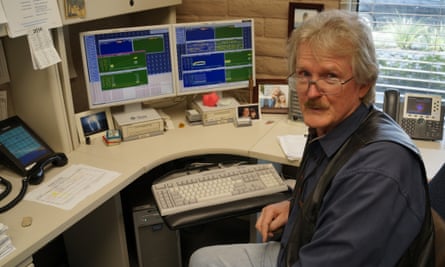
It is the Voyager spacecrafts’ longevity, despite their becoming a bit arthritic in later years, that has led to their Mission Control being moved out to an office park. The problem for Nasa – more correctly for the California Institute of Technology’s Jet Propulsion Laboratory , which runs most robotic missions for Nasa – is that high-profile later expeditions, most notably Curiosity, have used the available space on CalTech’s campus. Proud as JPL is of the amazing Voyager story, the craft are not taking photos or doing a lot of sexy science any more and may not encounter anything of much interest for another 40,000 years, by which time they will be deaf and mute. So, like a great grandfather who stubbornly refuses to do the decent thing, the Earth end of the Voyager programme and the spacecraft’s devoted carers have been put in a somewhat off-piste rest home.
Engineers are not given to emotion, but the romance of this incredible voyage of discovery has, by their own account, kept the ageing mission team together. Even latecomers, who were at school when Voyager was launched, have been working on the same mission for 30 years and more. “I’m in my mid-50s and treat the craft like my ageing parents,” says Suzy Dodd , who was 16 at launch, joined as a graduate student and whose card now proclaims surely one of the cooler job titles in science: Project manager, Voyager Interstellar Mission.
“You treat them with a certain amount of reverence; you know they’re stately spacecraft, venerable senior citizens, and you want to do everything possible for them to have a healthy lifetime,” she says. “You need to help them a bit because things have failed and you want to be careful other things don’t. Most of the engineers here have dedicated their career to this project. They have turned down opportunities for promotions and other things because they like Voyager so much they want to stay with it.”
It is clear talking to Voyager staff that they genuinely love their spacecraft, even though most were too young to see them before they flew, and it is more than possible that the older ones will have died before the Voyagers bleep their last. But as engineers, they have mixed feelings about the most famous aspect of that romance, the “golden record” that each craft carries. This is a gold-covered copper LP, packed with a needle and cartridge (plus instructions), and containing, in groove form, 115 photos from Earth, a selection of natural sounds from surf to whales, music from a variety of cultures and eras (the modern west is represented by Chuck Berry’s “Johnny B Goode”) and spoken greetings in 55 languages, from Akkadian, spoken in Sumer about 6,000 years ago, to Welsh.
Carl Sagan, who had the initial idea for the record, wrote in the 1970s: “The spacecraft will be encountered and the record played only if there are advanced spacefaring civilisations in interstellar space. But the launching of this bottle into the cosmic ocean says something very hopeful about life on this planet.” Sagan’s son Nick, then an infant, now a science-fiction novelist and screenwriter (his credits include Star Trek episodes), recorded the English message: “Hello from the children of planet Earth.” But one sure to make many tear up is the Mandarin: “Hope everyone’s well. We are thinking about you all. Please come here to visit when you have time.” (The messages are on the Voyager website, voyager.jpl.nasa.gov ).
Voyager’s mission controllers are less starry-eyed than Sagan about the golden records. You sense some feel that it was too much of a bow to religious sentiment. Steve Howard is one of the more positive on the record question. “Even though Earth may not be here, some intelligent being could pick it up and detect it. I would say that many of the civilisations are much more advanced and would detect something like that and simply go in and decipher it,” he says.
Suzy Dodd’s view is more typical of the team’s. “I think it’s a great idea to get humans and mankind thinking what-ifs. Let’s send a picture of ourselves vintage 1977 and put it on a spacecraft and send it out there forever. I think it’s done to connect us to the spacecraft more than for an alien running into it. I’m of the opinion that space is very empty and the chances of something finding it are remote. But that doesn’t diminish the fact that we’ve got a little time capsule out there travelling through space and now orbiting around in our galaxy. And that’s us.”
For the mission’s much-honoured chief scientist and spokesman since 1972, CalTech professor Ed Stone, aged 79, the romance of Voyager lies more in what it has discovered since he joined the project aged 36. “Yes, the Space Age was a young man’s game back then,” he says, not a little ruefully, sitting on a park bench on the green university campus. “We all knew we were on a mission of discovery. We just had no idea how much discovery there would be. We just kept finding things we didn’t know were there to be found.
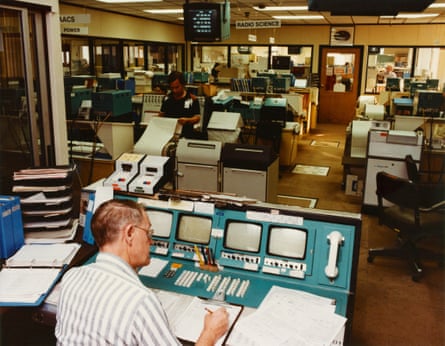
“For example, before Voyager, the only known volcanoes in the solar system were here on Earth. Then we flew by Jupiter’s moon, Io, which had 10 times the volcanic activity of Earth. Ten times! We detected hot lakes of lava on the surface. That was the first major discovery and it set the tone for the rest of the mission. And there are five instruments still working. But by 2025 the last will go off.”
He doesn’t quite add that by then he will be nearly 90, but does say, smiling: “Thing is, if you want to do space experiments, you have to be optimistic that it’s all going to work and that you’re going to find something worth the work. And you have to be patient, because nothing happens fast in space.”
Stone explains how, although it’s widely considered freakish that the Voyager crafts are still working so well – a TV left permanently on since Jim Callaghan’s day would be hardly working today – it’s less surprising to people like him who built them. To anyone familiar with the inside of a vintage radio or TV, the hand-soldered circuit boards, capacitors, transistors, resistors and so on that run a Voyager would look reassuringly familiar, which isn’t the case with a modern computer or phone, whose microchip-studded innards look more like something out of a UFO.
But the parts in Voyager weren’t as ordinary as they looked. Suzy Dodd, a “newcomer” to the project with just over 30 years’ service, has also been intrigued by the spacecraft’s durability. “The robustness is unique,” she says. “If you talk to the older engineers, they’ll say: ‘Well, we were told to make a four-year mission, but we realised if you just used this higher-rated component, it would last twice as long.’ So they did that. They just didn’t tell anybody. The early engineers were very conscious of trying to make this last as long as possible and, quite frankly, being not as forthcoming with information about the types of parts they were using.”
Even so, Ed Stone says, there have been problems. A ground controller’s error in April 1978 meant that Voyager 2 switched itself irretrievably to its back-up receiver – meaning that the craft has been receiving transmissions from Earth on a dodgy back-up radio for almost the entire mission. One of the original thrusters also failed.
For spacecraft 12bn miles from home and in their dotage, the Voyagers are quite tranquil machines today, but they do need watching. As Steve Howard is in his office inputting code in primordial programming language, on the floor of what passes for the main mission control Enrique Medina, 65, is watching streams of engineering data from the craft. A computer engineer, Medina is another of the eight full- and part-time controllers.
“One of us is always on call,” he says. “We’re all connected all the time by our smartphones. We will hear, that way, which engineering channel is out of tolerance and then we will connect from home with secure IDs and special codes, troubleshoot, determine and sometimes fix it from home. Or in some cases, one of us will drive in. That usually happens four to five times a month.
“Sometimes people are away, but we love Voyager so much that though it’s not part of our employment we’ll come in and do it anyway. Attitude control is my sub-system, but if the propulsion or the power needs attention, we all do multiple jobs,” he adds. “I’ve been working on Voyager since the Uranus encounter in 1986, and I will retire when Voyager retires in 2025. My wife doesn’t like that idea at all, as we already have a retirement place by the beach back in Mexico.”
Medina’s devotion to the Voyager is clear to see. “This has been part of my life for so long, and they pay us to do it, so how can you stop doing something you love? I even talk about the spacecraft like it’s a person, especially if it’s my sub-system.”
Steve Howard feels the same. “I just love to think of everything, all those 65,000 parts on each craft, working up there,” he says. “Oh man, it really is something. Every time we come in here, it’s just a gift. And you know that one day it could stop.”
Do these engineers ever think it might be more fun to be at the controls of Curiosity on the CalTech campus a couple of miles away?
“Yes, maybe,” says Medina, “but after so many years, you’re invested. It’s like being married to someone. It would be interesting to go out with Angelina Jolie, but do I want to give up my wife of 44 years, and my grandkids? I don’t think so. I would not give this up for something more interesting or newer.”
For the most part, Voyager is the reality of space – slow, patient science, humdrum perhaps, but real. It’s only a 20-minute drive from Altadena to Hollywood, where brilliant fake versions of space exploration like Christopher Nolan’s recent Interstellar are confected.
But Voyager, starring real people who keep tissues and tins of Altoids on their desks and real buildings rather than set designers’ glamorous fantasies, just happens to be the only real interstellar mission there will probably be in the lifetime of anyone alive today. It is surely one of the most amazing things in human history.
Follow the Observer Magazine on Twitter @ObsMagazine
- The Observer
Comments (…)
Most viewed.
- Skip to main content
- Keyboard shortcuts for audio player
Well, hello, Voyager 1! The venerable spacecraft is once again making sense

Nell Greenfieldboyce

Members of the Voyager team celebrate at NASA's Jet Propulsion Laboratory after receiving data about the health and status of Voyager 1 for the first time in months. NASA/JPL-Caltech hide caption
Members of the Voyager team celebrate at NASA's Jet Propulsion Laboratory after receiving data about the health and status of Voyager 1 for the first time in months.
NASA says it is once again able to get meaningful information back from the Voyager 1 probe, after months of troubleshooting a glitch that had this venerable spacecraft sending home messages that made no sense.
The Voyager 1 and Voyager 2 probes launched in 1977 on a mission to study Jupiter and Saturn but continued onward through the outer reaches of the solar system. In 2012, Voyager 1 became the first spacecraft to enter interstellar space, the previously unexplored region between the stars. (Its twin, traveling in a different direction, followed suit six years later.)
Voyager 1 had been faithfully sending back readings about this mysterious new environment for years — until November, when its messages suddenly became incoherent .

NASA's Voyager 1 spacecraft is talking nonsense. Its friends on Earth are worried
It was a serious problem that had longtime Voyager scientists worried that this historic space mission wouldn't be able to recover. They'd hoped to be able to get precious readings from the spacecraft for at least a few more years, until its power ran out and its very last science instrument quit working.
For the last five months, a small team at NASA's Jet Propulsion Laboratory in California has been working to fix it. The team finally pinpointed the problem to a memory chip and figured out how to restore some essential software code.
"When the mission flight team heard back from the spacecraft on April 20, they saw that the modification worked: For the first time in five months, they have been able to check the health and status of the spacecraft," NASA stated in an update.
The usable data being returned so far concerns the workings of the spacecraft's engineering systems. In the coming weeks, the team will do more of this software repair work so that Voyager 1 will also be able to send science data, letting researchers once again see what the probe encounters as it journeys through interstellar space.

After a 12.3 billion-mile 'shout,' NASA regains full contact with Voyager 2
- interstellar mission

Suggested Searches
- Climate Change
- Expedition 64
- Mars perseverance
- SpaceX Crew-2
- International Space Station
- View All Topics A-Z
Humans in Space
Earth & climate, the solar system, the universe, aeronautics, learning resources, news & events.

NASA-Led Study Provides New Global Accounting of Earth’s Rivers

NASA’s Hubble Pauses Science Due to Gyro Issue

NASA’s Optical Comms Demo Transmits Data Over 140 Million Miles
- Search All NASA Missions
- A to Z List of Missions
- Upcoming Launches and Landings
- Spaceships and Rockets
- Communicating with Missions
- James Webb Space Telescope
- Hubble Space Telescope
- Why Go to Space
- Astronauts Home
- Commercial Space
- Destinations
- Living in Space
- Explore Earth Science
- Earth, Our Planet
- Earth Science in Action
- Earth Multimedia
- Earth Science Researchers
- Pluto & Dwarf Planets
- Asteroids, Comets & Meteors
- The Kuiper Belt
- The Oort Cloud
- Skywatching
- The Search for Life in the Universe
- Black Holes
- The Big Bang
- Dark Energy & Dark Matter
- Earth Science
- Planetary Science
- Astrophysics & Space Science
- The Sun & Heliophysics
- Biological & Physical Sciences
- Lunar Science
- Citizen Science
- Astromaterials
- Aeronautics Research
- Human Space Travel Research
- Science in the Air
- NASA Aircraft
- Flight Innovation
- Supersonic Flight
- Air Traffic Solutions
- Green Aviation Tech
- Drones & You
- Technology Transfer & Spinoffs
- Space Travel Technology
- Technology Living in Space
- Manufacturing and Materials
- Science Instruments
- For Kids and Students
- For Educators
- For Colleges and Universities
- For Professionals
- Science for Everyone
- Requests for Exhibits, Artifacts, or Speakers
- STEM Engagement at NASA
- NASA's Impacts
- Centers and Facilities
- Directorates
- Organizations
- People of NASA
- Internships
- Our History
- Doing Business with NASA
- Get Involved
- Aeronáutica
- Ciencias Terrestres
- Sistema Solar
- All NASA News
- Video Series on NASA+
- Newsletters
- Social Media
- Media Resources
- Upcoming Launches & Landings
- Virtual Events
- Sounds and Ringtones
- Interactives
- STEM Multimedia

Correction and Clarification of C.26 Rapid Mission Design Studies for Mars Sample Return

NASA’s Commercial Partners Deliver Cargo, Crew for Station Science

NASA Shares Lessons of Human Systems Integration with Industry

Work Underway on Large Cargo Landers for NASA’s Artemis Moon Missions

NASA’s ORCA, AirHARP Projects Paved Way for PACE to Reach Space

Amendment 11: Physical Oceanography not solicited in ROSES-2024

Why is Methane Seeping on Mars? NASA Scientists Have New Ideas

Mars Science Laboratory: Curiosity Rover

Hubble Spots a Magnificent Barred Galaxy

NASA’s Chandra Releases Doubleheader of Blockbuster Hits

Explore the Universe with the First E-Book from NASA’s Fermi

NASA Grant Brings Students at Underserved Institutions to the Stars

NASA Photographer Honored for Thrilling Inverted In-Flight Image

NASA’s Ingenuity Mars Helicopter Team Says Goodbye … for Now

NASA Langley Team to Study Weather During Eclipse Using Uncrewed Vehicles

NASA Data Helps Beavers Build Back Streams

NASA’s Near Space Network Enables PACE Climate Mission to ‘Phone Home’

Washington State High Schooler Wins 2024 NASA Student Art Contest

NASA STEM Artemis Moon Trees

Kiyun Kim: From Intern to Accessibility Advocate

Diez maneras en que los estudiantes pueden prepararse para ser astronautas

Astronauta de la NASA Marcos Berríos

Resultados científicos revolucionarios en la estación espacial de 2023
45 years ago: voyager 1 begins its epic journey to the outer planets and beyond, johnson space center.
Forty-five years ago, the Voyager 1 spacecraft began an epic journey that continues to this day. The second of a pair of spacecraft, Voyager 1 lifted off on Sept. 5, 1977, 16 days after its twin left on a similar voyage. NASA’s Jet Propulsion Laboratory (JPL) in Pasadena, California, managed the two spacecraft on their missions to explore the outer planets. Taking advantage of a rare planetary alignment to use the gravity of one planet to redirect the spacecraft to the next, the Voyagers planned to use Jupiter’s gravity to send them on to explore Saturn and its large moon Titan. They carried sophisticated instruments to conduct their in-depth explorations of the giant planets. Both spacecraft continue to return data as they make their way out of our solar system and enter interstellar space.
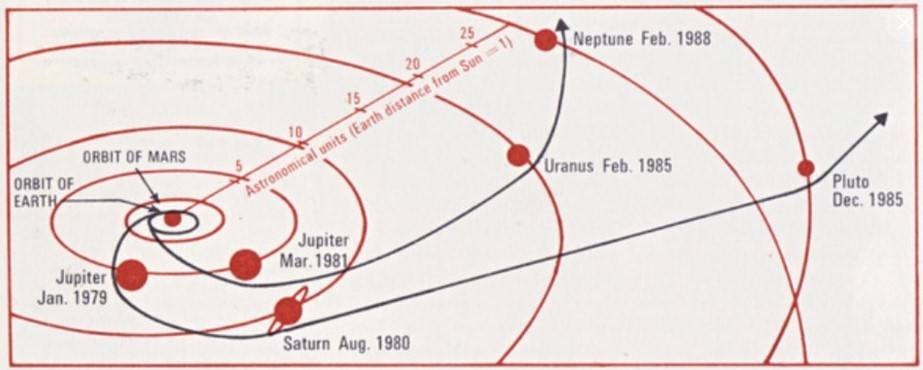
In the 1960s, mission designers at JPL noted that the next occurrence of a once-every-175-year alignment of the outer planets would happen in the late 1970s. A spacecraft could take advantage of this opportunity to fly by Jupiter and use its gravity to bend its trajectory to visit Saturn, and repeat the process to also visit Uranus, Neptune, and Pluto. Launching several missions to visit each planet individually would take much longer and cost much more. The original plan to send two pairs of Thermoelectric Outer Planet Spacecraft on these Grand Tours proved too costly leading to its cancellation in 1971. The next year, NASA approved a scaled-down version of the project to send a pair of Mariner-class spacecraft in 1977 to explore just Jupiter and Saturn, with an expected five-year operational life. On March 7, 1977, NASA Administrator James C. Fletcher announced the renaming of these Mariner Jupiter/Saturn 1977 spacecraft as Voyager 1 and 2. Scientists held out hope that one of them could ultimately visit Uranus and Neptune, thereby fulfilling most of the original Grand Tour’s objectives – Pluto would have to wait several decades for its first visit.
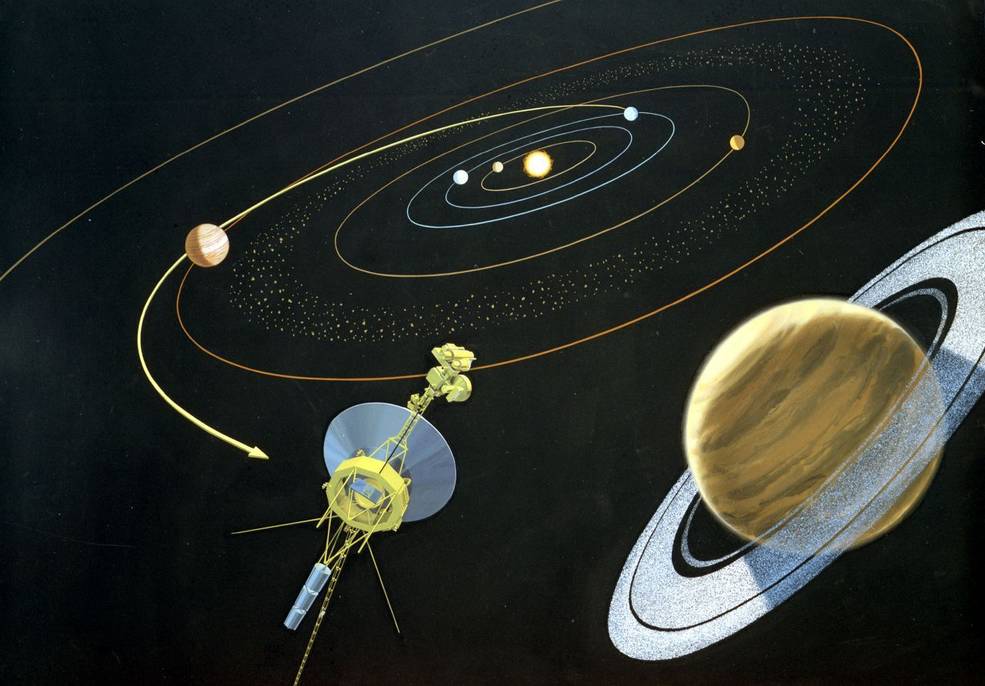
Each Voyager carried a suite of 11 instruments to study the planets during each encounter and to learn more about interplanetary space in the outer reaches of the solar system, including:
- An imaging science system consisting of narrow-angle and wide-angle cameras to photograph the planet and its satellites.
- A radio science system to determine the planet’s physical properties.
- An infrared interferometer spectrometer to investigate local and global energy balance and atmospheric composition.
- An ultraviolet spectrometer to measure atmospheric properties.
- A magnetometer to analyze the planet’s magnetic field and interaction with the solar wind.
- A plasma spectrometer to investigate microscopic properties of plasma ions.
- A low-energy charged particle device to measure fluxes and distributions of ions.
- A cosmic ray detection system to determine the origin and behavior of cosmic radiation.
- A planetary radio astronomy investigation to study radio emissions from Jupiter.
- A photopolarimeter to measure the planet’s surface composition.
- A plasma wave system to study the planet’s magnetosphere.
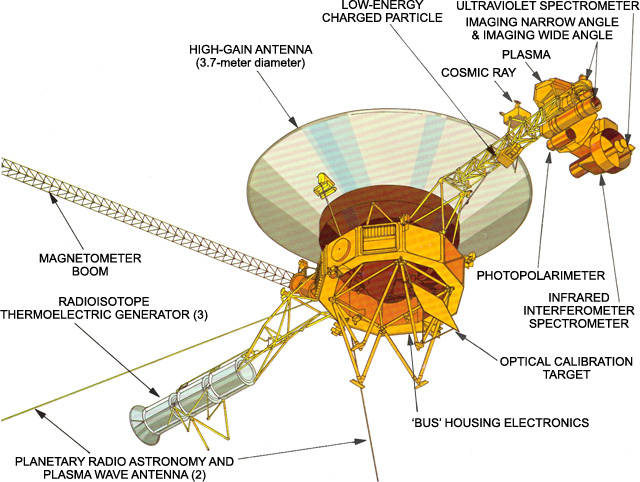
Voyager 1 lifted off on Sept. 5, 1977, atop a Titan IIIE-Centaur rocket from Launch Complex 41 at Cape Canaveral Air Force Station, now Cape Canaveral Space Force Station, in Florida. Two weeks after its launch, from a distance of 7.25 million miles, Voyager 1 turned its camera back toward its home planet and took the first single-frame image of the Earth-Moon system. The spacecraft successfully crossed the asteroid belt between Dec. 10, 1977, and Sept. 8, 1978.
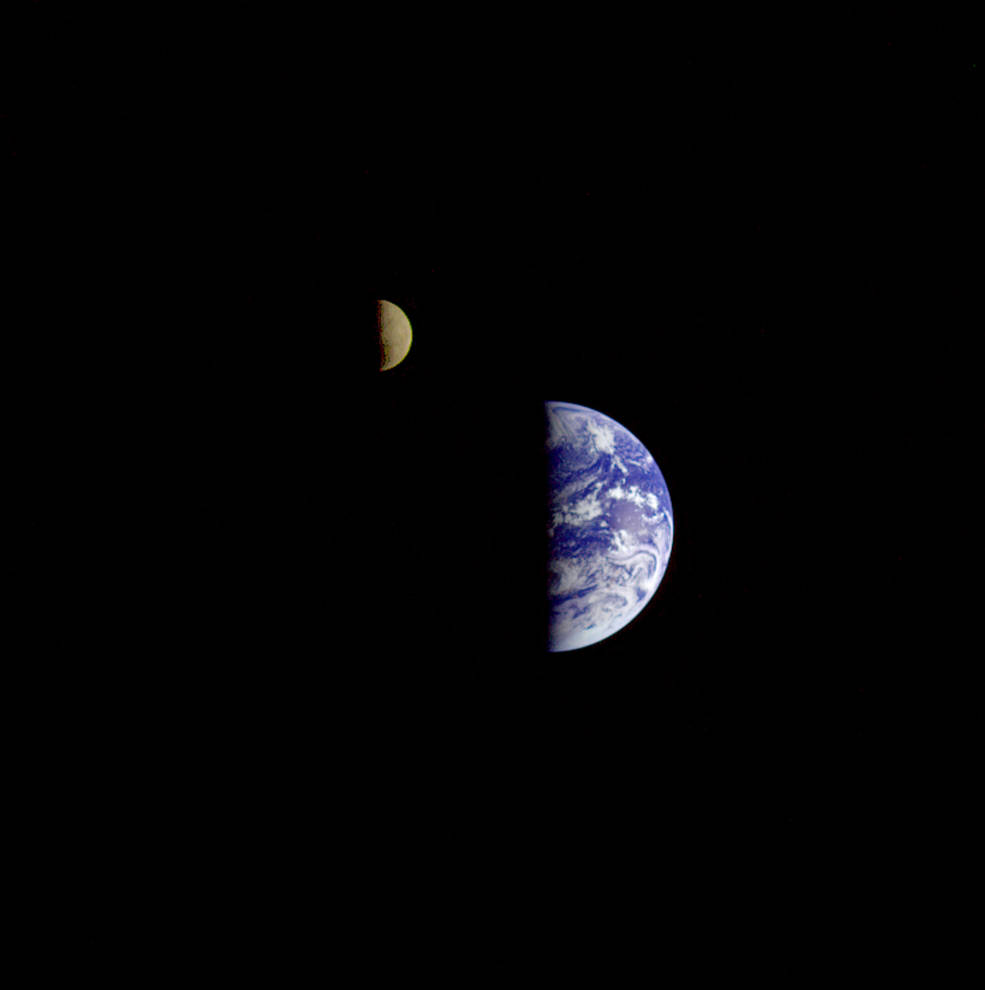
Although Voyager 1 launched two weeks after its twin, it traveled on a faster trajectory and arrived at Jupiter four months earlier. Voyager 1 conducted its observations of Jupiter between Jan. 6 and April 13, 1979, making its closest approach of 216,837 miles from the planet’s center on March 5. The spacecraft returned 19,000 images of the giant planet, many of Jupiter’s satellites, and confirmed the presence of a thin ring encircling it. Its other instruments returned information about Jupiter’s atmosphere and magnetic field. Jupiter’s massive gravity field bent the spacecraft’s trajectory and accelerated it toward Saturn.
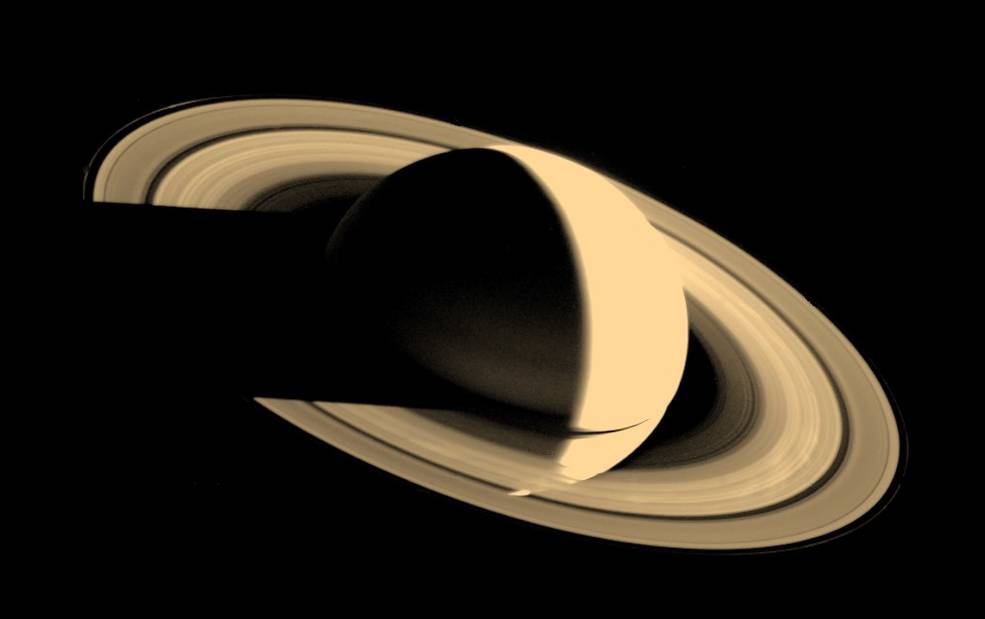
Voyager 1 began its long-range observations of Saturn on Aug. 22, 1980, passed within 114,500 miles of the planet’s center on Nov. 12, and concluded its studies on Dec. 14. Because of its interest to scientists, mission planners chose the spacecraft’s trajectory to make a close flyby of Saturn’s largest moon Titan – the only planetary satellite with a dense atmosphere – just before the closest approach to the planet itself. This trajectory, passing over Saturn’s south pole and bending north over the plane of the ecliptic, precluded Voyager 1 from making any additional planetary encounters. The spacecraft flew 4,033 miles from Titan’s center, returning images of its unbroken orange atmosphere and high-altitude blue haze layer. During the encounter, Voyager 1 returned 16,000 photographs, imaging Saturn, its rings, many of its known satellites and discovering several new ones, while its instruments returned data about Saturn’s atmosphere and magnetic field.

On Feb. 14, 1990, more than 12 years after it began its journey from Earth and shortly before controllers permanently turned off its cameras to conserve power, Voyager 1 spun around and pointed them back into the solar system. In a mosaic of 60 images, it captured a “family portrait” of six of the solar system’s planets, including a pale blue dot called Earth more than 3.7 billion miles away. Fittingly, these were the last pictures returned from either Voyager spacecraft. On Feb. 17, 1998, Voyager 1 became the most distant human-made object, overtaking the Pioneer 10 spacecraft on their way out of the solar system. In February 2020, to commemorate the photograph’s 30th anniversary, NASA released a remastered version of the image of Earth as Pale Blue Dot Revisited .
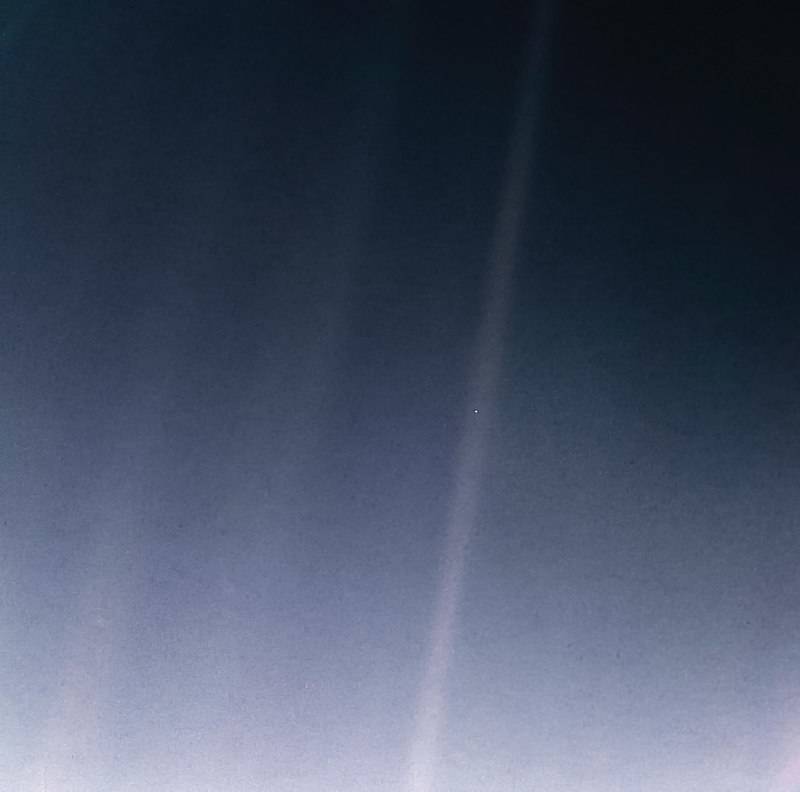
On New Year’s Day 1990, both spacecraft officially began the Voyager Interstellar Mission as they inexorably made their escape from our solar system. On Aug. 25, 2012, Voyager 1 passed beyond the heliopause, the boundary between the heliosphere, the bubble-like region of space created by the Sun, and the interstellar medium. Its twin followed suit six years later. Today , 45 years after its launch and 14.6 billion miles from Earth, four of Voyager 1’s 11 instruments continue to return useful data, having now spent 10 years in interstellar space. Signals from the spacecraft take nearly 22 hours to reach Earth, and 22 hours for Earth-based signals to reach the spacecraft. Engineers expect that the spacecraft will continue to return data from interstellar space until about 2025 when it will no longer be able to power its systems. And just in case an alien intelligence finds it one day, Voyager 1 like its twin carries a gold-plated record that contains information about its home planet, including recordings of terrestrial sounds, music, and greetings in 55 languages. Engineers at NASA thoughtfully included Instructions on how to play the record.
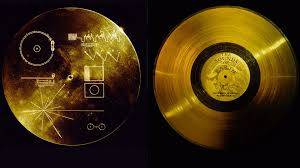
The voyage continues…

Voyager 1 and Voyager 2
Where are they now.
Both Voyager 1 and Voyager 2 have reached "interstellar space" and each continue their unique journey deeper into the cosmos. In NASA's Eyes on the Solar System app, you can see the actual spacecraft trajectories of the Voyagers updated every five minutes.
Mission Status
Instrument status.
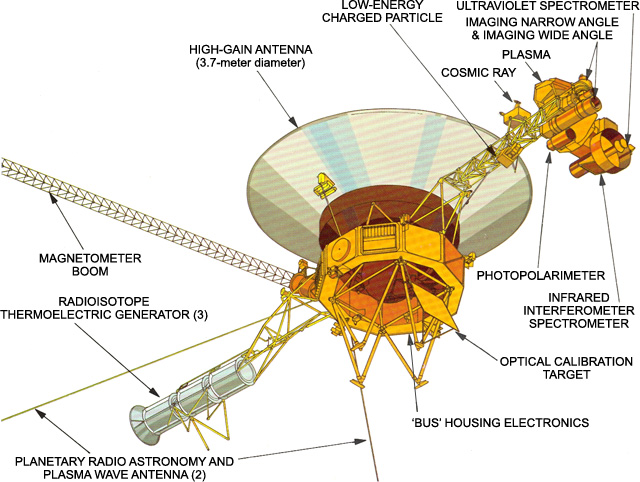
Voyager 1 Present Position
Voyager 2 present position, voyager's grand tour: 1977 - today.
NASA’s Voyager 1 Resumes Sending Engineering Updates to Earth

NASA’s Voyager 1 spacecraft is depicted in this artist’s concept traveling through interstellar space, or the space between stars, which it entered in 2012.
After some inventive sleuthing, the mission team can — for the first time in five months — check the health and status of the most distant human-made object in existence.
For the first time since November , NASA’s Voyager 1 spacecraft is returning usable data about the health and status of its onboard engineering systems. The next step is to enable the spacecraft to begin returning science data again. The probe and its twin, Voyager 2, are the only spacecraft to ever fly in interstellar space (the space between stars).
Voyager 1 stopped sending readable science and engineering data back to Earth on Nov. 14, 2023, even though mission controllers could tell the spacecraft was still receiving their commands and otherwise operating normally. In March, the Voyager engineering team at NASA’s Jet Propulsion Laboratory in Southern California confirmed that the issue was tied to one of the spacecraft’s three onboard computers, called the flight data subsystem (FDS). The FDS is responsible for packaging the science and engineering data before it’s sent to Earth.

After receiving data about the health and status of Voyager 1 for the first time in five months, members of the Voyager flight team celebrate in a conference room at NASA’s Jet Propulsion Laboratory on April 20.
The team discovered that a single chip responsible for storing a portion of the FDS memory — including some of the FDS computer’s software code — isn’t working. The loss of that code rendered the science and engineering data unusable. Unable to repair the chip, the team decided to place the affected code elsewhere in the FDS memory. But no single location is large enough to hold the section of code in its entirety.
So they devised a plan to divide the affected code into sections and store those sections in different places in the FDS. To make this plan work, they also needed to adjust those code sections to ensure, for example, that they all still function as a whole. Any references to the location of that code in other parts of the FDS memory needed to be updated as well.
The team started by singling out the code responsible for packaging the spacecraft’s engineering data. They sent it to its new location in the FDS memory on April 18. A radio signal takes about 22 ½ hours to reach Voyager 1, which is over 15 billion miles (24 billion kilometers) from Earth, and another 22 ½ hours for a signal to come back to Earth. When the mission flight team heard back from the spacecraft on April 20, they saw that the modification worked: For the first time in five months, they have been able to check the health and status of the spacecraft.
Get the Latest News from the Final Frontier
During the coming weeks, the team will relocate and adjust the other affected portions of the FDS software. These include the portions that will start returning science data.
Voyager 2 continues to operate normally. Launched over 46 years ago , the twin Voyager spacecraft are the longest-running and most distant spacecraft in history. Before the start of their interstellar exploration, both probes flew by Saturn and Jupiter, and Voyager 2 flew by Uranus and Neptune.
Caltech in Pasadena, California, manages JPL for NASA.
News Media Contact
Calla Cofield
Jet Propulsion Laboratory, Pasadena, Calif.
626-808-2469
- Share full article
Advertisement
Supported by
Voyager 1, First Craft in Interstellar Space, May Have Gone Dark
The 46-year-old probe, which flew by Jupiter and Saturn in its youth and inspired earthlings with images of the planet as a “Pale Blue Dot,” hasn’t sent usable data from interstellar space in months.

By Orlando Mayorquin
When Voyager 1 launched in 1977, scientists hoped it could do what it was built to do and take up-close images of Jupiter and Saturn. It did that — and much more.
Voyager 1 discovered active volcanoes, moons and planetary rings, proving along the way that Earth and all of humanity could be squished into a single pixel in a photograph, a “ pale blue dot, ” as the astronomer Carl Sagan called it. It stretched a four-year mission into the present day, embarking on the deepest journey ever into space.
Now, it may have bid its final farewell to that faraway dot.
Voyager 1 , the farthest man-made object in space, hasn’t sent coherent data to Earth since November. NASA has been trying to diagnose what the Voyager mission’s project manager, Suzanne Dodd, called the “most serious issue” the robotic probe has faced since she took the job in 2010.
The spacecraft encountered a glitch in one of its computers that has eliminated its ability to send engineering and science data back to Earth.
The loss of Voyager 1 would cap decades of scientific breakthroughs and signal the beginning of the end for a mission that has given shape to humanity’s most distant ambition and inspired generations to look to the skies.
“Scientifically, it’s a big loss,” Ms. Dodd said. “I think — emotionally — it’s maybe even a bigger loss.”
Voyager 1 is one half of the Voyager mission. It has a twin spacecraft, Voyager 2.
Launched in 1977, they were primarily built for a four-year trip to Jupiter and Saturn , expanding on earlier flybys by the Pioneer 10 and 11 probes.
The Voyager mission capitalized on a rare alignment of the outer planets — once every 175 years — allowing the probes to visit all four.
Using the gravity of each planet, the Voyager spacecraft could swing onto the next, according to NASA .
The mission to Jupiter and Saturn was a success.
The 1980s flybys yielded several new discoveries, including new insights about the so-called great red spot on Jupiter, the rings around Saturn and the many moons of each planet.
Voyager 2 also explored Uranus and Neptune , becoming in 1989 the only spacecraft to explore all four outer planets.

Voyager 1, meanwhile, had set a course for deep space, using its camera to photograph the planets it was leaving behind along the way. Voyager 2 would later begin its own trek into deep space.
“Anybody who is interested in space is interested in the things Voyager discovered about the outer planets and their moons,” said Kate Howells, the public education specialist at the Planetary Society, an organization co-founded by Dr. Sagan to promote space exploration.
“But I think the pale blue dot was one of those things that was sort of more poetic and touching,” she added.
On Valentine’s Day 1990, Voyager 1, darting 3.7 billion miles away from the sun toward the outer reaches of the solar system, turned around and snapped a photo of Earth that Dr. Sagan and others understood to be a humbling self-portrait of humanity.
“It’s known the world over, and it does connect humanity to the stars,” Ms. Dodd said of the mission.
She added: “I’ve had many, many many people come up to me and say: ‘Wow, I love Voyager. It’s what got me excited about space. It’s what got me thinking about our place here on Earth and what that means.’”
Ms. Howells, 35, counts herself among those people.
About 10 years ago, to celebrate the beginning of her space career, Ms. Howells spent her first paycheck from the Planetary Society to get a Voyager tattoo.
Though spacecraft “all kind of look the same,” she said, more people recognize the tattoo than she anticipated.
“I think that speaks to how famous Voyager is,” she said.
The Voyagers made their mark on popular culture , inspiring a highly intelligent “Voyager 6” in “Star Trek: The Motion Picture” and references on “The X Files” and “The West Wing.”
Even as more advanced probes were launched from Earth, Voyager 1 continued to reliably enrich our understanding of space.
In 2012, it became the first man-made object to exit the heliosphere, the space around the solar system directly influenced by the sun. There is a technical debate among scientists around whether Voyager 1 has actually left the solar system, but, nonetheless, it became interstellar — traversing the space between stars.
That charted a new path for heliophysics, which looks at how the sun influences the space around it. In 2018, Voyager 2 followed its twin between the stars.
Before Voyager 1, scientific data on the sun’s gases and material came only from within the heliosphere’s confines, according to Dr. Jamie Rankin, Voyager’s deputy project scientist.
“And so now we can for the first time kind of connect the inside-out view from the outside-in,” Dr. Rankin said, “That’s a big part of it,” she added. “But the other half is simply that a lot of this material can’t be measured any other way than sending a spacecraft out there.”
Voyager 1 and 2 are the only such spacecraft. Before it went offline, Voyager 1 had been studying an anomalous disturbance in the magnetic field and plasma particles in interstellar space.
“Nothing else is getting launched to go out there,” Ms. Dodd said. “So that’s why we’re spending the time and being careful about trying to recover this spacecraft — because the science is so valuable.”
But recovery means getting under the hood of an aging spacecraft more than 15 billion miles away, equipped with the technology of yesteryear. It takes 45 hours to exchange information with the craft.
It has been repeated over the years that a smartphone has hundreds of thousands of times Voyager 1’s memory — and that the radio transmitter emits as many watts as a refrigerator lightbulb.
“There was one analogy given that is it’s like trying to figure out where your cursor is on your laptop screen when your laptop screen doesn’t work,” Ms. Dodd said.
Her team is still holding out hope, she said, especially as the tantalizing 50th launch anniversary in 2027 approaches. Voyager 1 has survived glitches before, though none as serious.
Voyager 2 is still operational, but aging. It has faced its own technical difficulties too.
NASA had already estimated that the nuclear-powered generators of both spacecrafts would likely die around 2025.
Even if the Voyager interstellar mission is near its end, the voyage still has far to go.
Voyager 1 and its twin, each 40,000 years away from the next closest star, will arguably remain on an indefinite mission.
“If Voyager should sometime in its distant future encounter beings from some other civilization in space, it bears a message,” Dr. Sagan said in a 1980 interview .
Each spacecraft carries a gold-plated phonograph record loaded with an array of sound recordings and images representing humanity’s richness, its diverse cultures and life on Earth.
“A gift across the cosmic ocean from one island of civilization to another,” Dr. Sagan said.
Orlando Mayorquin is a general assignment and breaking news reporter based in New York. More about Orlando Mayorquin
What’s Up in Space and Astronomy
Keep track of things going on in our solar system and all around the universe..
Never miss an eclipse, a meteor shower, a rocket launch or any other 2024 event that’s out of this world with our space and astronomy calendar .
Scientists may have discovered a major flaw in their understanding of dark energy, a mysterious cosmic force . That could be good news for the fate of the universe.
A new set of computer simulations, which take into account the effects of stars moving past our solar system, has effectively made it harder to predict Earth’s future and reconstruct its past.
Dante Lauretta, the planetary scientist who led the OSIRIS-REx mission to retrieve a handful of space dust , discusses his next final frontier.
A nova named T Coronae Borealis lit up the night about 80 years ago. Astronomers say it’s expected to put on another show in the coming months.
Is Pluto a planet? And what is a planet, anyway? Test your knowledge here .
NASA's Voyager 1 spacecraft finally phones home after 5 months of no contact
On Saturday, April 5, Voyager 1 finally "phoned home" and updated its NASA operating team about its health.

NASA's interstellar explorer Voyager 1 is finally communicating with ground control in an understandable way again. On Saturday (April 20), Voyager 1 updated ground control about its health status for the first time in 5 months. While the Voyager 1 spacecraft still isn't sending valid science data back to Earth, it is now returning usable information about the health and operating status of its onboard engineering systems.
Thirty-five years after its launch in 1977, Voyager 1 became the first human-made object to leave the solar system and enter interstellar space . It was followed out of our cosmic quarters by its space-faring sibling, Voyager 2 , six years later in 2018. Voyager 2, thankfully, is still operational and communicating well with Earth.
The two spacecraft remain the only human-made objects exploring space beyond the influence of the sun. However, on Nov. 14, 2023, after 11 years of exploring interstellar space and while sitting a staggering 15 billion miles (24 billion kilometers) from Earth, Voyager 1's binary code — computer language composed of 0s and 1s that it uses to communicate with its flight team at NASA — stopped making sense.
Related: We finally know why NASA's Voyager 1 spacecraft stopped communicating — scientists are working on a fix
In March, NASA's Voyager 1 operating team sent a digital "poke" to the spacecraft, prompting its flight data subsystem (FDS) to send a full memory readout back home.
This memory dump revealed to scientists and engineers that the "glitch" is the result of a corrupted code contained on a single chip representing around 3% of the FDS memory. The loss of this code rendered Voyager 1's science and engineering data unusable.

The NASA team can't physically repair or replace this chip, of course, but what they can do is remotely place the affected code elsewhere in the FDS memory. Though no single section of the memory is large enough to hold this code entirely, the team can slice it into sections and store these chunks separately. To do this, they will also have to adjust the relevant storage sections to ensure the addition of this corrupted code won't cause those areas to stop operating individually, or working together as a whole. In addition to this, NASA staff will also have to ensure any references to the corrupted code's location are updated.
Get the Space.com Newsletter
Breaking space news, the latest updates on rocket launches, skywatching events and more!
— Voyager 2: An iconic spacecraft that's still exploring 45 years on
— NASA's interstellar Voyager probes get software updates beamed from 12 billion miles away
— NASA Voyager 2 spacecraft extends its interstellar science mission for 3 more years
On April 18, 2024, the team began sending the code to its new location in the FDS memory. This was a painstaking process, as a radio signal takes 22.5 hours to traverse the distance between Earth and Voyager 1, and it then takes another 22.5 hours to get a signal back from the craft.
By Saturday (April 20), however, the team confirmed their modification had worked. For the first time in five months, the scientists were able to communicate with Voyager 1 and check its health. Over the next few weeks, the team will work on adjusting the rest of the FDS software and aim to recover the regions of the system that are responsible for packaging and returning vital science data from beyond the limits of the solar system.
Join our Space Forums to keep talking space on the latest missions, night sky and more! And if you have a news tip, correction or comment, let us know at: [email protected].

Robert Lea is a science journalist in the U.K. whose articles have been published in Physics World, New Scientist, Astronomy Magazine, All About Space, Newsweek and ZME Science. He also writes about science communication for Elsevier and the European Journal of Physics. Rob holds a bachelor of science degree in physics and astronomy from the U.K.’s Open University. Follow him on Twitter @sciencef1rst.
SpaceX launches Falcon 9 rocket on record-tying 20th mission
Boeing Starliner 1st astronaut flight: Live updates
Russia vetoes UN resolution against nuclear weapons in space
- Robb62 'V'ger must contact the creator. Reply
- Holy HannaH! Couldn't help but think that "repair" sounded extremely similar to the mechanics of DNA and the evolution of life. Reply
- Torbjorn Larsson *Applause* indeed, thanks to the Voyager teams for the hard work! Reply
- SpaceSpinner I notice that the article says that it has been in space for 35 years. Either I have gone back in time 10 years, or their AI is off by 10 years. V-*ger has been captured! Reply
Admin said: On Saturday, April 5, Voyager 1 finally "phoned home" and updated its NASA operating team about its health. The interstellar explorer is back in touch after five months of sending back nonsense data. NASA's Voyager 1 spacecraft finally phones home after 5 months of no contact : Read more
evw said: I'm incredibly grateful for the persistence and dedication of the Voyagers' teams and for the amazing accomplishments that have kept these two spacecrafts operational so many years beyond their expected lifetimes. V-1 was launched when I was 25 years young; I was nearly delirious with joy. Exploring the physical universe captivated my attention while I was in elementary school and has kept me mesmerized since. I'm very emotional writing this note, thinking about what amounts to a miracle of technology and longevity in my eyes. BRAVO!!! THANK YOU EVERYONE PAST & PRESENT!!!
- EBairead I presume it's Fortran. Well done all. Reply
SpaceSpinner said: I notice that the article says that it has been in space for 35 years. Either I have gone back in time 10 years, or their AI is off by 10 years. V-*ger has been captured!
EBairead said: I presume it's Fortran. Well done all.
- View All 11 Comments
Most Popular
- 2 Beavers are helping fight climate change, satellite data shows
- 3 Astronomers just discovered a comet that could be brighter than most stars when we see it next year. Or will it?
- 4 This Week In Space podcast: Episode 108 — Starliner: Better Late Than Never?
- 5 Boeing's Starliner spacecraft will not fly private missions yet, officials say
- Work & Careers
- Life & Arts
Become an FT subscriber
Try unlimited access Only $1 for 4 weeks
Then $75 per month. Complete digital access to quality FT journalism on any device. Cancel anytime during your trial.
- Global news & analysis
- Expert opinion
- Special features
- FirstFT newsletter
- Videos & Podcasts
- Android & iOS app
- FT Edit app
- 10 gift articles per month
Explore more offers.
Standard digital.
- FT Digital Edition
Premium Digital
Print + premium digital, weekend print + standard digital, weekend print + premium digital.
Today's FT newspaper for easy reading on any device. This does not include ft.com or FT App access.
- 10 additional gift articles per month
- Global news & analysis
- Exclusive FT analysis
- Videos & Podcasts
- FT App on Android & iOS
- Everything in Standard Digital
- Premium newsletters
- Weekday Print Edition
- FT Weekend Print delivery
- Everything in Premium Digital
Essential digital access to quality FT journalism on any device. Pay a year upfront and save 20%.
- Everything in Print
Complete digital access to quality FT journalism with expert analysis from industry leaders. Pay a year upfront and save 20%.
Terms & Conditions apply
Explore our full range of subscriptions.
Why the ft.
See why over a million readers pay to read the Financial Times.
International Edition
After months of silence, Voyager 1 has returned NASA’s calls

- Show more sharing options
- Copy Link URL Copied!
For the last five months, it seemed very possible that a 46-year-old conversation had finally reached its end.
Since its launch from Kennedy Space Center on Sept. 5, 1977, NASA’s Voyager 1 spacecraft has diligently sent regular updates to Earth on the health of its systems and data collected from its onboard instruments.
But in November, the craft went quiet.
Voyager 1 is now some 15 billion miles away from Earth. Somewhere in the cold interstellar space between our sun and the closest stars, its flight data system stopped communicating with the part of the probe that allows it to send signals back to Earth. Engineers at the Jet Propulsion Laboratory in La Cañada Flintridge could tell that Voyager 1 was getting its messages, but nothing was coming back.
“We’re to the point where the hardware is starting to age,” said Linda Spilker, the project scientist for the Voyager mission. “It’s like working on an antique car, from 15 billion miles away.”
Week after week, engineers sent troubleshooting commands to the spacecraft, each time patiently waiting the 45 hours it takes to get a response here on Earth — 22.5 hours traveling at the speed of light to reach the probe, and 22.5 hours back.

Science & Medicine
This space artist created the Golden Record and changed the way we see the universe
Space artist Jon Lomberg has produced work that attempts to visualize what we can’t truly see, and to communicate with creatures we can’t yet imagine.
July 26, 2023
By March, the team had figured out that a memory chip that stored some of the flight data system’s software code had failed, turning the craft’s outgoing communications into gibberish.
A long-distance repair wasn’t possible. There wasn’t enough space anywhere in the system to shift the code in its entirety. So after manually reviewing the code line by line, engineers broke it up and tucked the pieces into the available slots of memory.
They sent a command to Voyager on Thursday. In the early morning hours Saturday, the team gathered around a conference table at JPL: laptops open, coffee and boxes of doughnuts in reach.
At 6:41 a.m., data from the craft showed up on their screens. The fix had worked .
“We went from very quiet and just waiting patiently to cheers and high-fives and big smiles and sighs of relief,” Spilker said. “I’m very happy to once again have a meaningful conversation with Voyager 1.”
Voyager 1 is one of two identical space probes. Voyager 2, launched two weeks before Voyager 1, is now about 13 billion miles from Earth, the two crafts’ trajectories having diverged somewhere around Saturn. (Voyager 2 continued its weekly communications uninterrupted during Voyager 1’s outage.)

Space shuttle Endeavour is lifted into the sky, takes final position as star of new museum wing
A shrink-wrapped Endeavour was hoisted and then carefully placed in its final location Tuesday at the still-under-construction Samuel Oschin Air and Space Center.
Jan. 30, 2024
They are the farthest-flung human-made objects in the universe, having traveled farther from their home planet than anything else this species has built. The task of keeping communications going grows harder with each passing day. Every 24 hours, Voyager 1 travels 912,000 miles farther away from us. As that distance grows, the signal becomes slower and weaker.
When the probe visited Jupiter in 1979, it was sending back data at a rate of 115.2 kilobits per second, Spilker said. Today, 45 years and more than 14 billion miles later, data come back at a rate of 40 bits per second.
The team is cautiously optimistic that the probes will stay in contact for three more years, long enough to celebrate the mission’s 50th anniversary in 2027, Spilker said. They could conceivably last until the 2030s.
The conversation can’t last forever. Microscopic bits of silica keep clogging up the thrusters that keep the probes’ antennas pointed toward Earth, which could end communications. The power is running low. Eventually, the day will come when both Voyagers stop transmitting data to Earth, and the first part of their mission ends.
But on the day each craft goes quiet, they begin a new era, one that could potentially last far longer. Each probe is equipped with a metallic album cover containing a Golden Record , a gold-plated copper disk inscribed with sounds and images meant to describe the species that built the Voyagers and the planet they came from.
Erosion in space is negligible; the images could be readable for another billion years or more. Should any other intelligent life form encounter one of the Voyager probes and have a means of retrieving the data from the record, they will at the very least have a chance to figure out who sent them — even if our species is by that time long gone.
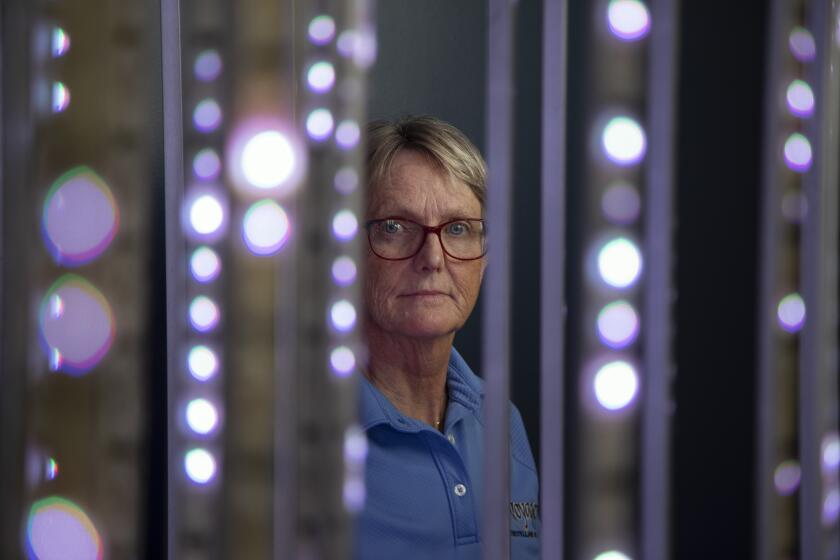
JPL tries to keep Voyager space probes from disconnecting the world’s longest phone call
Keeping in touch with NASA’s two aging Voyager spacecraft is getting harder to do as they get farther away and their power sources dwindle.
Sept. 3, 2022
More to Read

Too expensive, too slow: NASA asks for help with JPL’s Mars Sample Return mission
April 15, 2024

NASA’s attempt to bring home part of Mars is unprecedented. The mission’s problems are not
March 25, 2024
Budget deal for NASA offers glimmer of hope for JPL’s Mars Sample Return mission
March 6, 2024

Corinne Purtill is a science and medicine reporter for the Los Angeles Times. Her writing on science and human behavior has appeared in the New Yorker, the New York Times, Time Magazine, the BBC, Quartz and elsewhere. Before joining The Times, she worked as the senior London correspondent for GlobalPost (now PRI) and as a reporter and assignment editor at the Cambodia Daily in Phnom Penh. She is a native of Southern California and a graduate of Stanford University.
More From the Los Angeles Times

Post Malone’s all-star Stagecoach set includes Brad Paisley, Dwight Yoakam
April 27, 2024

L.A. supervisors oppose plan to eradicate Catalina deer by shooting them from helicopters
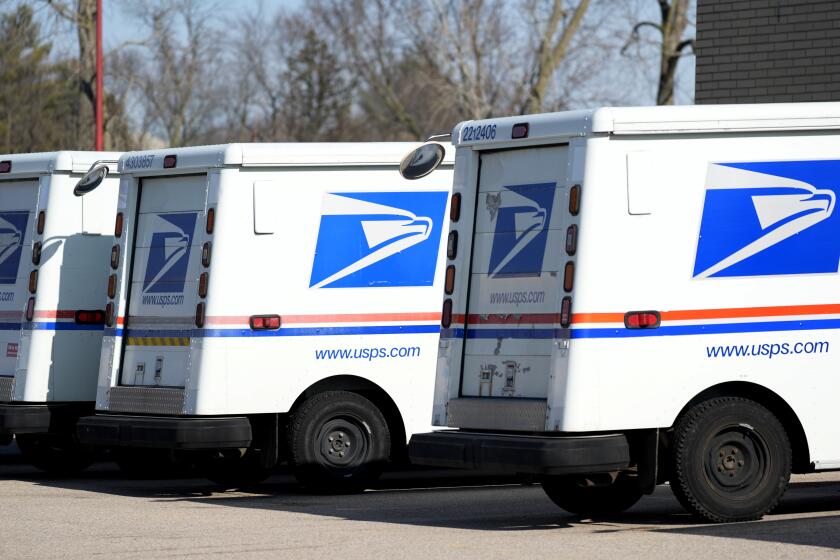

Southern California woman pleads guilty in $150-million counterfeit postage scheme

Person stabbed after argument spills out of L.A. Metro bus, police say
April 26, 2024

NASA Just Repaired Voyager 1 From 15 Billion Miles Away
L ast month, NASA scientists received distressing news from Voyager 1, the first craft to travel outside of our solar system. Signals from the probe had ceased transmitting — and the fear was that, after 46 years of traveling through space, that might be the end of the line for Voyager 1. Given its distance from Earth, it’s not like NASA could send up a repair crew to get Voyager 1 back in working order. Instead, they were limited to communicating with the probe via radio signals, with a delay of almost a day between then sending a signal and Voyager receiving it.
That’s not the only challenge facing the scientists exploring repair options. There was also the matter of the file storage space available to them — remember, the probe launched 46 years ago, so adding in a few terabytes of solid-state storage wasn’t an option. And yet, here’s the thing: they did it. Voyager 1 is once again working properly and transmitting signals to Earth.
NASA explained in detail just how its scientists were able to get Voyager working again. As NASA’s Naomi Hartono described it, a chip that maintained Voyager 1’s science and engineering data stopped working — and given the limits of 1970s technology, there wasn’t anywhere large enough to store comparable code. Instead, the scientists divided the code into multiple sections, while also working to make sure that the update wouldn’t cause anything currently operational to stop working.
Looking to Live on Mars Without Leaving Earth? NASA Has an Opportunity For You.
Radio signals take 22.5 hours to get from Earth to Voyager 1 and a comparable time for the probe to get a signal back to Earth. On April 20, NASA received its first signal from Voyager 1 in months.
Currently, the only data Voyager 1 is properly transmitting has to do with the craft’s own internal status. The next step for the scientists monitoring Voyager 1 is getting it to send data about the environment through which it’s currently traveling. You know, interstellar space. Right now, Voyager is 15,000,000,000 miles from Earth — and our connection to it endures.
More Like This
Nasa atmospheric satellite ends run 16 years after launch, nasa’s new space exploration robot moves like a snake, nasa readies mission to better understand supernovas, this nasa spacecraft just spent 17 years monitoring the sun.
This article was featured in the InsideHook newsletter. Sign up now .
The post NASA Just Repaired Voyager 1 From 15 Billion Miles Away appeared first on InsideHook .
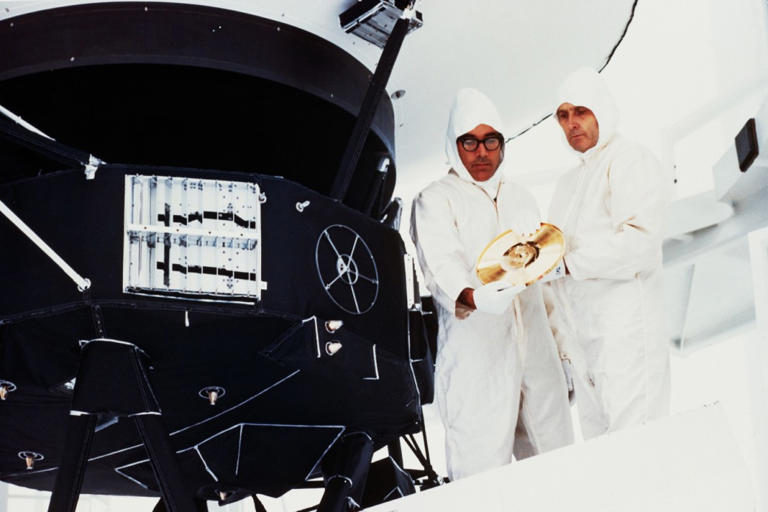

USS Voyager personnel
- View history
An Intrepid -class starship such as USS Voyager normally had a complement of approximately 150 crew. When Voyager left drydock, its crew complement was 153. During the tumultuous voyage to and through the Delta Quadrant , many of those were lost. But there were also several new crewmembers taken on, first from Chakotay 's Maquis and the Ocampa sector, and later from the Borg and the USS Equinox . In 2371 , Voyager had a crew complement of 141, ( VOY : " Caretaker ") whereas in 2373 it was 148 ( VOY : " Distant Origin ", " Displaced ") and in 2375 and 2378 the number was 146. ( VOY : " Someone to Watch Over Me ", " Author, Author ")
In 2373 , Vorik stated that 73 of the crewmembers were male. ( VOY : " Blood Fever ") There were two Vulcans and two Betazoids listed on the crew manifest, with one of the Betazoids, Lon Suder , having previously been killed by the Kazon in 2373, the other being ensign Jurot . In mid- 2377 , Lt. B'Elanna Torres stated that there were 140 Humans aboard Voyager . ( VOY : " Basics, Part II ", " Counterpoint ", " Lineage ")
Crew manifest [ ]
Crew manifest : Some names have notations as to where each crewperson joined Voyager . All the Maquis crewmen had provisional Starfleet ranks.
- Crewman Lydia Anderson
- Lieutenant Andrews ( security )
- Lieutenant Arkinson
- Ensign Ashmore ( engineering )
- Lieutenant Ayala ( Maquis , relief conn )
- Azan ( civilian , Ex-Borg , 2376-2377)
- Ensign Lyndsay Ballard (engineering, 2371-2374 KIA)
- Commander J. Bartlett (KIA)
- Lieutenant Walter Baxter (command/operations division)
- Ensign Pablo Baytart (relief conn)
- Crewman Kurt Bendera (Maquis, engineering, 2371-2372 KIA)
- Ensign Bennet (relief conn, 2371-2372 KIA)
- Commander Rick Berman
- Lieutenant Commander Alan Bernard ( Planetary Geosciences Division )
- Lieutenant David Bernard
- Crewman Biddle
- Lieutenant Ken Biller
- Lieutenant Commander Bob Blackman
- Ensign Blain
- Lieutenant Jerry Bono
- Lieutenant Mary Ellen Bosché
- Crewman Boylan (engineering)
- Commander Brannon Braga
- Ensign Freddy Bristow
- Ensign Doug Bronowski ( airponics bay )
- Ensign Brooks
- Lieutenant Commander Dick Brownfield
- Ensign Daniel Byrd (in an alternate timeline )
- Zayra Cabot
- Valerie Canamar
- Lieutenant Joe Carey (assistant engineer, 2371-2377 KIA)
- Crewman Carlson (Maquis, 2371-2378)
- Lieutenant Commander Cavit ( XO , KIA 2371)
- Commander Chakotay (Maquis, XO )
- Lieutenant Mandy Chamberlin
- Lieutenant William Chapman
- Ed Charnock, Jr.
- Jay Chattaway
- Crewman Chell (Maquis)
- Lieutenant Joe Chess
- John Chichester
- Ian Christenberry
- Lieutenant Richard Chronister
- Lieutenant Tom Conley
- Ensign Claudia Craig (KIA)
- Ensign Culhane (relief conn)
- Lieutenant Dick D'Angelo
- Crewman Kenneth Dalby (Maquis)
- Crewman Frank Darwin (2371-2372 KIA)
- Bob De La Garza (2371)
- Lisa De Moraes (2371)
- Lieutenant Commander Doug Dean (Planetary Geosciences Division; 2371-72)
- Crewman Jenny Delaney ( astrometrics )
- Crewman Megan Delaney (astrometrics)
- Crewman Dell (engineering)
- Ensign Michael DeMeritt (2371-2374)
- Jon Djanrelian (2371)
- The Doctor ( EMH Chief Medical Officer )
- Crewman Dorado
- Lieutenant Louise Dorton
- Crewman Doyle (Maquis)
- Ensign Wendy Drapanas (2371-2374)
- Lieutenant Pete Durst (security, KIA 2371)
- Crewman Emmanuel
- Ensign Farley
- Lieutenant Kristine Fernandez
- Crewman Fitzpatrick
- Ensign Jerry Fleck
- Crewman Foster
- Crewman Frank
- Ensign Arlene Fukai
- Crewman Gennaro
- Lieutenant Cosmo Genovese
- Crewman Gerron (Maquis, 2371-2378)
- Crewman Patrick Gibson
- Crewman Marla Gilmore (transferred from USS Equinox , (2376-2378)
- Ensign Golwat
- Crewman Grimes (relief conn)
- Crewman Hamilton
- Lieutenant Hargrove
- Ensign Harper
- Crewman Mortimer Harren
- Crewman Henard
- Crewman Henley (Maquis)
- Ensign Hickman (astrometrics)
- Ensign Hogan (Maquis, 2371-2372 KIA)
- Lieutenant Commander Merri Howard
- Icheb (civilian, former Borg drone, 2376-2378)
- Lieutenant Phil Jacobson
- Crewman Jackson (Maquis)
- Lieutenant Commander Richard James
- Captain Kathryn Janeway ( CO , 2371-2378)
- Crewman Jarvin (Maquis)
- Crewman Jarvis (security)
- Ensign Jenkins (relief conn)
- Ensign Ahni Jetal (2371-2373, KIA)
- Lieutenant Ralph Johnson
- Crewman Michael Jonas (Maquis, 2371-2372 KIA)
- Crewman Jones
- Crewman Jor (Maquis, engineering)
- Ensign Jurot
- Ensign Kaplan
- Ensign Marie Kaplan (2371-2373 KIA)
- Kellin (briefly in 2374)
- Kes ( hydroponics bay , civilian picked up at Ocampa , 2371-2374)
- Ensign Harry Kim ( operations officer , 2371-2378)
- Ensign Kyoto
- Ensign Lang (security)
- Crewman Timothy Lang (operations, KIA)
- Crewman Larson
- Lieutenant Commander Peter Lauritson
- Crewman Noah Lessing (transferred from USS Equinox , 2376-)
- Crewman Lewis
- Lieutenant Commander David Livingston
- Junie Lowry-Johnson
- Lieutenant J. Lyman (KIA)
- Dennis Madalone
- Jim Magdaleno
- Ensign Mannus
- Marika Wilkarah (former Borg drone)
- Ensign Martin (2371-2373 KIA)
- Crewman MacAlister
- Ensign Macormak
- Dennis McCarthy
- Lieutenant Commander L. McGarry (KIA)
- Crewman William McKenzie
- Lieutenant Scott McKnight
- Crewman McMinn
- Lieutenant James Mees
- Crewman Mendez (engineering)
- Mezoti (civilian, former Borg drone, 2376-2377)
- Crewman Mitchell
- Ensign Molina (security)
- Ronald B. Moore
- Crewman James Morrow (transferred from USS Equinox , 2376)
- Ensign Mulchaey (engineering)
- Ensign Murphy (science)
- Ensign Murphy (security)
- Morale Officer Neelix (head chef / ambassador to the Delta Quadrant /chief morale officer , Talaxian civilian picked up near Ocampa, 2371-2378)
- Ensign John Nesterowicz
- Lieutenant John Nesterowicz
- Lieutenant Susan Nicoletti (engineering)
- Crewman Kashimuro Nozawa
- Crewman O'Donnell (Maquis, 2371-2378)
- One (briefly, 2375, KIA)
- David Orlando
- Lieutenant Diane Overdiek
- Lieutenant junior grade Tom Paris (reactivated commission, conn, demoted to ensign 2375, regained lt. jg rank 2376)
- Miral Paris (civilian, born 2378 )
- Ensign Michael Parsons (security)
- Lieutenant Bill Peets
- Crewman Sandra Peterson
- Lieutenant Commander Michael Piller
- Crewman Jerry Platt
- Crewman Amanda Porter
- Q (civilian, 2377 )
- Quinn ( 2372 , deceased)
- Charlie Quizzlink
- Pierre Rahn
- Evelyn Rameau
- Abraham Rawski
- Rebi (civilian, ex-Borg, 2376 - 2377 )
- Barbara Reen
- Tony Reynolds
- Crewman Robertson
- Keith Rockefeller
- Crewman Rogers
- Ensign Rollins
- George Rosa
- Lieutenant David Rossi
- Lieutenant Commander Marvin Rush
- Lieutenant Russell
- Ensign Ryson
- Christopher Sarion
- Henri Scheimer
- John Schoolcraft
- Lieutenant S. Seaborn (KIA)
- Lieutenant Sandra Sena
- Michael Sendine
- Ensign Seska (Maquis/ Cardassian spy, engineering, defected to the Kazon 2371)
- Ikuyo Seuphon
- Seven of Nine ( astrometrics )
- Ensign Renlay Sharr
- Crewman Sharr
- Hindaki Shibunawa
- India Shigihara
- Lieutenant Suzi Shimizu
- Ensign Adele Simmons
- Lieutenant Alan Sims
- Ann Smithee (Maquis)
- Crewman Brian Sofin (transferred from USS Equinox , 2376-)
- Lieutenant Stadi (conn, KIA 2371)
- David Stipes
- Lieutenant Michael Stradling
- Ensign Strickler
- Crewman Lon Suder (Maquis, engineering, 2371-2373 KIA)
- Ensign Rick Sternbach
- Lieutenant Mark Stimson
- Crewman Swift
- Ensign Swinn
- Ensign Tabor (Maquis, 2371- )
- Crewman Tal Celes (astrometrics)
- Crewman Angelo Tassoni (transferred from USS Equinox , 2376- )
- Commander Jeri Taylor
- Crewman William Telfer
- Crewman Thompson
- Lieutenant Bill Thoms
- Lieutenant Jim Thorpe
- Lieutenant B'Elanna Torres (Maquis, chief engineer , 2371-2378)
- Ensign Trumari
- Lieutenant Tuvix ( security chief / chief tactical officer / chief morale officer / head chef , briefly, 2372, KIA)
- Lieutenant Commander Tuvok (security chief / chief tactical officer, 2371-2378)
- Crewman Unai
- Ensign Vorik (engineering)
- Lieutenant Weiss
- Crewman White
- Ensign Samantha Wildman (sciences, 2371-2378)
- Naomi Wildman (civilian, born 2372)
- Lieutenant Commander Brad Yacobian
- Crewman Yosa (Maquis, engineering 2371-2378)
- Ensign Charles Young (KIA)
- Lieutenant Commander T. Ziegler (KIA)
Unnamed personnel [ ]
- Unnamed USS Voyager personnel
See also [ ]
- List of Voyager recurring character appearances
External link [ ]
- USS Voyager personnel at Memory Beta , the wiki for licensed Star Trek works
- 3 ISS Enterprise (NCC-1701)

- The Contents
- The Making of
- Where Are They Now
- Frequently Asked Questions
- Q & A with Ed Stone
golden record
Where are they now.
- frequently asked questions
- Q&A with Ed Stone
Mission Status
Instrument status.

Where are the Voyagers now?
To learn more about Voyager, zoom in and give the spacecraft a spin. View the full interactive experience at Eyes on the Solar System . Credit: NASA/JPL-Caltech
View Voyager
Space Flight Operations Schedule (SFOS)
SFOS files showing Voyager activity on Deep Space Network (DSN)
2024 Tracking Schedule
2023 tracking schedule, 2022 tracking schedule, 2021 tracking schedule, 2020 tracking schedule, 2019 tracking schedule, 2018 tracking schedule, 2017 tracking schedule, 2016 tracking schedule, 2015 tracking schedule, 2014 tracking schedule, 2013 tracking schedule, 2012 tracking schedule, 2011 tracking schedule, 2010 tracking schedule, 2009 tracking schedule, 2008 tracking schedule, 2007 tracking schedule, 2006 tracking schedule, 2005 tracking schedule, 2004 tracking schedule, 2003 tracking schedule, 2002 tracking schedule, 2001 tracking schedule, 2000 tracking schedule, 1999 tracking schedule, 1998 tracking schedule, 1997 tracking schedule, 1996 tracking schedule, 1995 tracking schedule, 1994 tracking schedule.

- [ April 27, 2024 ] SpaceX launches European Commission’s Galileo satellites on Falcon 9 rocket from the Kennedy Space Center Falcon 9
- [ April 27, 2024 ] News from the Press Site: Boeing Starliner gets go ahead for Crew Flight Test, communication reestablished with Voyager 1 News
- [ April 25, 2024 ] NASA astronauts arrive at Kennedy Space Center ahead of Boeing Starliner Crew Flight Test Atlas 5
- [ April 23, 2024 ] Rocket Lab launches NASA, Korean payloads on Electron flight Electron
- [ April 23, 2024 ] SpaceX completes 300th Falcon booster landing during Starlink mission Falcon 9
News from the Press Site: Boeing Starliner gets go ahead for Crew Flight Test, communication reestablished with Voyager 1
In this week’s edition of News from the Press Site, Spaceflight Now’s Will Robinson-Smith is joined by Tariq Malik, editor-in-chief of Space.com, and Passant Robie, space reporter for Gizmodo. The panel discusses the arrival of the NASA astronauts who will be the first to fly onboard Boeing’s CST-100 Starliner, the reestablishment of contact with the Voyager 1 spacecraft, the 300th Falcon 9 booster landing for SpaceX and much more.
News from the Press Site is a weekly video podcast where we cover the big space news of the week with some of the journalists covering it on the daily.
Tariq Malik, Space.com:
- The 2024 solar eclipse was a teachable moment in more ways than one https://www.space.com/total-solar-eclipse-2024-teachable-moment-suny-potsdam-university
- Chasing the 2024 solar eclipse means dorm life for some New York spectators (including me) https://www.space.com/solar-eclipse-2024-dorm-life-suny-potsdam-new-york
- Russian Soyuz rocket suffers rare last-minute abort during launch of 3 astronauts to ISS (video) https://www.space.com/soyuz-rocket-launch-abort-expedition71-astronauts
Passant Robie, Gizmodo:
- Hubble Telescope Put Into Dreaded Safe Mode Due to Ongoing Glitch https://gizmodo.com/hubble-telescope-put-into-dreaded-safe-mode-due-to-ongo-1851438846
- Russia’s UN Veto Fuels More Tension With the US Over Nuclear Weapons in Space https://gizmodo.com/russia-un-veto-tensions-nuclear-weapons-space-1851438358
- Chinese Astronauts Performed Emergency Space Station Repairs Following Debris Impact https://gizmodo.com/chinese-astronauts-space-station-repairs-debris-impact-1851434957
- CST-100 Starliner Crew Flight Test
- News from the Press Site
Related Articles

Video: Iridium payload released from Falcon 9 rocket in orbit
Watch a replay from a camera mounted on-board SpaceX’s Falcon 9 rocket as it released one of 10 Iridium Next communications satellites Monday nearly 400 miles above Earth.

SpaceX ready for 33-engine test of Starship’s Super Heavy booster
SpaceX is gearing up for the first full-up test-firing Thursday of all 33 engines on the booster for the company’s Starship mega-rocket in Texas, a critical milestone on the path to launching the giant vehicle on its first orbital test flight, which could happen as soon as March if this week’s test goes well.
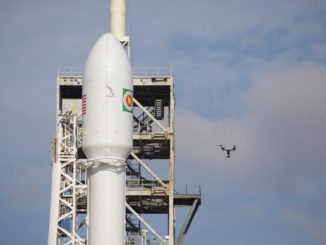
Photos: Falcon 9 Block 5 poised for launch at Kennedy Space Center
SpaceX’s first upgraded Falcon 9 “Block 5” rocket was raised vertical at launch pad 39A early Thursday in preparation for liftoff from the Kennedy Space Center, debuting enhancements aimed at making the booster more reusable and more reliable.
© 1999-2024 Spaceflight Now Inc
share this!
April 27, 2024
This article has been reviewed according to Science X's editorial process and policies . Editors have highlighted the following attributes while ensuring the content's credibility:
fact-checked
reputable news agency
Astronauts arrive at Kennedy Space Center as first crew for Boeing's Starliner spacecraft
by Richard Tribou, Orlando Sentinel
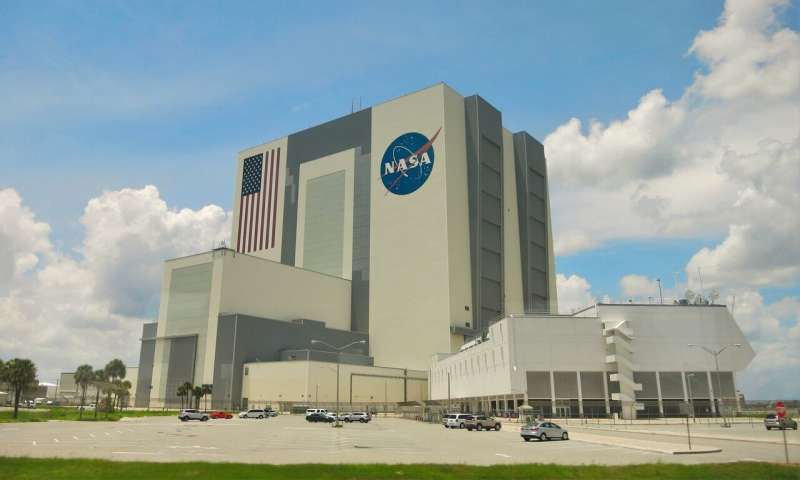
It's not just another ride for a pair of veteran NASA astronauts who arrived to the Space Coast ahead of their flight onboard Boeing's CST-100 Starliner.
Barry "Butch" Wilmore and Sunita "Suni" Williams, who both joined NASA's astronaut corps more than two decades ago, will be the commander and pilot for the Crew Flight Test mission of the much-delayed spacecraft.
It's set to launch with humans on board for the first time atop an Atlas V rocket from Cape Canaveral Space Force Station's Space Launch Complex 41 on May 6 at 10:34 p.m., headed to the International Space Station.
The pair flew into KSC in their T-38 jets, landing at the former space shuttle landing facility Thursday afternoon and speaking with reporters ahead of the vanguard mission.
"This mission going off well? Of course we want it to do that," said Wilmore from the tarmac. "Do we expect it to go perfectly? This is the first human flight of the spacecraft. I'm sure we'll find things out. That's why we do this. This is a test flight . When you do test, you expect to find things. And we expect to find things."
Wilmore, who was part of NASA's 2000 astronaut class, was the pilot for STS-129 on board Space Shuttle Atlantis for an 11-day mission in 2009 and then stayed on board the ISS for nearly five months from 2014–2015. Williams was part of NASA's 1998 astronaut class and had two long-term stays on board the ISS, first flying in 2006 on Space Shuttle Discovery on STS-116 and flying home on Space Shuttle Atlantis on STS-117 in 2007 after 192 days in space. She then flew on a Soyuz in 2012 for a four-month stay on board.
This is the third trip to space for both, but the pair are not resting on their laurels with 11 days to go before launch. Wilmore said the coming days could be summed up in three words.
"Review, review, and review—everything we've been working on. There's so much into this, there's a fair amount of responsibility, obviously, that we hold," he said. "We are ready. But we want to stay ready. We've got a week to continue to make sure that there's not a single event that we have prepared for that we're not ready for."
This marks only the sixth new U.S.-based spacecraft to carry humans following Mercury, Gemini, Apollo, the space shuttle and the most recent entrant, SpaceX's Crew Dragon. Dragon's first human spaceflight came nearly four years ago, launching May 30, 2020, with its own pair of veteran NASA astronauts, Bob Behnken and Doug Hurley.
Williams said she got a pep talk from Behnken.
"I just got a text from Bob last night, and he was pretty pumped that we were coming down here. He was like, "I'm reliving it in my mind where we were,'" she said. "He gives us his best and is ready for us to go fly."
SpaceX and Boeing had been running fairly close in development at the end of the last decade as one of two companies NASA awarded contracts for under its Commercial Crew Program. The goal of the program was to replace U.S.-based flights after the end of the Space Shuttle Program in 2011, which forced a reliance on Russia for flights to the ISS on board Soyuz spacecraft.
Starliner, though, ran into trouble on its first uncrewed test flight in December 2019 and was not able to rendezvous with the ISS, forcing a major overhaul of Boeing's program including hardware, software and management changes. That led to the successful redo of that uncrewed test flight in 2022, but further hardware delays have now made it so next month's planned launch will come more than four years behind schedule.
Since then, SpaceX has proceeded full bore, having now flown 50 humans to space onboard its fleet of four Crew Dragon spacecraft on 13 missions, and has three more on the schedule to fly before the end of the year.
Wilmore said Starliner took longer, but it's time.
"We've had a few delays because we weren't ready," he said. "There are literally 1,000 events that are taking place simultaneously as you step up and get prepared to launch and during the launch sequence, and then the spacecraft itself when we're on orbit."
But he's adamant all the parts are in place.
"There's so much going on. It is not easy. I think we make it look easy. That's our goal," he said. "We want the general public to think it's easy, but it's not. It's way hard. We wouldn't be here if we weren't ready. We are ready. The spacecraft's ready. And the teams are ready."
Boeing's CFT mission now aims for about an eight-day stay on board the ISS. The major goals for its crew are to test out both docking backup systems on approach and landing operations when it heads back to Earth, which will feature a parachute-assisted touchdown in the western U.S., unlike the watery splashdowns off the Florida coast taken by SpaceX's Crew Dragon.
If successful, it lines Boeing up to begin operational missions to the ISS as early as February 2025. That first mission, dubbed Starliner-1, has three of its four crew members already named.
Boeing is contracted for six crew rotation mission through the end of the ISS's operation as early as 2030. SpaceX and Boeing would transition to sharing one mission each per year for NASA until the ISS is decommissioned.
For her part, Williams pumped up Starliner's role in the NASA program now, as well as its role with NASA's future Artemis program missions on the Orion spacecraft.
"It has a lot of similar things that Orion has," she said. "So I think if I was a young astronaut, and I was thinking about going to the moon, I think I'd put my hand up and say I want to fly Starliner."
2024 Orlando Sentinel. Distributed by Tribune Content Agency, LLC.
Explore further
Feedback to editors

Global study shows a third more insects come out after dark
19 hours ago

Cicada-palooza! Billions of bugs to blanket America
21 hours ago

Getting dynamic information from static snapshots

Ancient Maya blessed their ballcourts: Researchers find evidence of ceremonial offerings in Mexico

Optical barcodes expand range of high-resolution sensor
Apr 26, 2024

Ridesourcing platforms thrive on socio-economic inequality, say researchers

Did Vesuvius bury the home of the first Roman emperor?

Florida dolphin found with highly pathogenic avian flu: Report

A new way to study and help prevent landslides

New algorithm cuts through 'noisy' data to better predict tipping points
Relevant physicsforums posts, black holes colliding exactly head on, need help simplifying standard error formula for redshift, our beautiful universe - photos and videos.
Apr 25, 2024
Solar Activity and Space Weather Update thread
'devil' comet visible tonight 21.04.24, waves in space.
More from Astronomy and Astrophysics
Related Stories

Boeing 1 month out from 4 years of catchup to SpaceX with 1st crewed Starliner flight
Apr 4, 2024

Next up is launch, as Boeing's Starliner takes trek to Cape Canaveral
Apr 17, 2024

NASA astronauts arrive for Boeing's first human spaceflight

NASA, Boeing aiming for July launch of Starliner space capsule
Mar 29, 2023

In 2024, Space Coast gears up for most astronaut launches since '09
Nov 20, 2023

Astronaut chooses daughter's wedding over space test flight
Oct 7, 2020
Recommended for you

Japan's moon lander wasn't built to survive a weekslong lunar night. It's still going after 3
Apr 24, 2024

NASA's Voyager 1 resumes sending engineering updates to Earth
Apr 22, 2024

Simulated microgravity affects sleep and physiological rhythms, study finds

'Tube map' around planets and moons made possible by knot theory

NASA's Ingenuity Mars helicopter team says goodbye—for now

NASA confirms mystery object that crashed through roof of Florida home came from space station
Apr 16, 2024
Let us know if there is a problem with our content
Use this form if you have come across a typo, inaccuracy or would like to send an edit request for the content on this page. For general inquiries, please use our contact form . For general feedback, use the public comments section below (please adhere to guidelines ).
Please select the most appropriate category to facilitate processing of your request
Thank you for taking time to provide your feedback to the editors.
Your feedback is important to us. However, we do not guarantee individual replies due to the high volume of messages.
E-mail the story
Your email address is used only to let the recipient know who sent the email. Neither your address nor the recipient's address will be used for any other purpose. The information you enter will appear in your e-mail message and is not retained by Phys.org in any form.
Newsletter sign up
Get weekly and/or daily updates delivered to your inbox. You can unsubscribe at any time and we'll never share your details to third parties.
More information Privacy policy
Donate and enjoy an ad-free experience
We keep our content available to everyone. Consider supporting Science X's mission by getting a premium account.
E-mail newsletter
- Cast & crew
- User reviews
- Episode aired Feb 21, 2001

Almost the entire Voyager crew has been abducted and brainwashed to serve as workers in a severely short-handed industrial alien society. Almost the entire Voyager crew has been abducted and brainwashed to serve as workers in a severely short-handed industrial alien society. Almost the entire Voyager crew has been abducted and brainwashed to serve as workers in a severely short-handed industrial alien society.
- Allan Kroeker
- Gene Roddenberry
- Rick Berman
- Michael Piller
- Kate Mulgrew
- Robert Beltran
- Roxann Dawson
- 14 User reviews
- 4 Critic reviews

- Capt. Kathryn Janeway

- Cmdr. Chakotay

- Lt. B'Elanna Torres

- Lt. Tom Paris

- Seven of Nine

- Ensign Harry Kim

- Quarren Ambassador

- Security Officer #2
- (as Matt Williamson)

- Security Officer #1
- All cast & crew
- Production, box office & more at IMDbPro
Did you know
- Trivia For the second time in the series, The Doctor is the only one left on Voyager that can do anything, and other crew members are off-ship. The first time was Macrocosm (1996) when the crew was incapacitated.
- Goofs When Neelix shows B'Elanna around her quarters, trying to help her remember, the bat'leth hanging on the wall is not the one given to her by the Klingons in a previous episode. The one hanging resembles Worf's bat'leth.
Harry Kim : I'm still feeling kinda queasy from that nectar.
The Doctor : I treated you days ago!
Harry Kim : Whatever you did hasn't worked. Maybe all those command subroutines are compromising your medical abilities.
The Doctor : Maybe all that sarcasm is compromising your natural charm.
- Connections Referenced in After Trek: Si Vis Pacem, Para Bellum (2017)
- Soundtracks Star Trek: Voyager - Main Title (uncredited) Written by Jerry Goldsmith Performed by Jay Chattaway
User reviews 14
- Sep 18, 2018
- February 21, 2001 (United States)
- United States
- Official site
- Paramount Studios - 5555 Melrose Avenue, Hollywood, Los Angeles, California, USA (Studio)
- Paramount Television
- See more company credits at IMDbPro
Technical specs
- Runtime 43 minutes
- Dolby Digital
Related news
Contribute to this page.
- IMDb Answers: Help fill gaps in our data
- Learn more about contributing
More to explore

Recently viewed

COMMENTS
The Voyager 1 probe is the most distant human-made object in existence. After a major effort to restore communication with it, NASA announced success this week. IE 11 is not supported.
In 1977, Voyager 1 and 2 started their one-way journey across our galaxy, travelling a million miles a day. Jonathan Margolis meets the dedicated team keeping the craft moving. O n a chilly March ...
Voyager 1 is a space probe launched by NASA on September 5, 1977, as part of the Voyager program to study the outer Solar System and the interstellar space beyond the Sun's heliosphere. It was launched 16 days after its twin Voyager 2.
The Voyager 1 and Voyager 2 probes launched in 1977 on a mission to study Jupiter and Saturn but continued onward through the outer reaches of the solar system. In 2012, Voyager 1 became the first ...
Voyager 1 has been exploring our solar system for more than 45 years. The probe is now in interstellar space, the region outside the heliopause, or the bubble of energetic particles and magnetic fields from the Sun. Voyager 1 is the first human-made object to venture into interstellar space. Voyager 1 discovered a thin ring around Jupiter and ...
NASA. Sep 12, 2013. RELEASE 13-280. NASA's Voyager 1 spacecraft officially is the first human-made object to venture into interstellar space. The 36-year-old probe is about 12 billion miles (19 billion kilometers) from our sun. New and unexpected data indicate Voyager 1 has been traveling for about one year through plasma, or ionized gas ...
Mission Overview. The twin Voyager 1 and 2 spacecraft are exploring where nothing from Earth has flown before. Continuing on their more-than-40-year journey since their 1977 launches, they each are much farther away from Earth and the sun than Pluto. In August 2012, Voyager 1 made the historic entry into interstellar space, the region between ...
An Insider's Guide to Voyager: 1977-2017. Image of Voyager team members began their careers in the early days of the mission. From the first detection of active volcanoes outside Earth to the first up-close images of Neptune, the 40-year Odyssey of NASA's Voyager mission is full of unforgettable memories. Voyager 1, the farthest human-made ...
In 1990, as it ascended the void, Voyager 1's crew commanded it to turn its cameras backward and snap a family portrait of the worlds it was leaving forever behind.
About the mission. Voyager 1 reached interstellar space in August 2012 and is the most distant human-made object in existence. Launched just shortly after its twin spacecraft, Voyager 2, in 1977, Voyager 1 explored the Jovian and Saturnian systems discovering new moons, active volcanoes and a wealth of data about the outer solar system.
Today, 45 years after its launch and 14.6 billion miles from Earth, four of Voyager 1's 11 instruments continue to return useful data, having now spent 10 years in interstellar space. Signals from the spacecraft take nearly 22 hours to reach Earth, and 22 hours for Earth-based signals to reach the spacecraft.
Voyager 1 Present Position. This simulated view of the solar system allows you to explore the planets, moons, asteroids, comets, and spacecraft exploring our solar system. You can also fast-forward and rewind in real-time. NASA/JPL-Caltech.
A poster of the planets and moons visited during the Voyager program. The Voyager program is an American scientific program that employs two interstellar probes, Voyager 1 and Voyager 2.They were launched in 1977 to take advantage of a favorable alignment of the two gas giants Jupiter and Saturn and the ice giants, Uranus and Neptune, to fly near them while collecting data for transmission ...
The probe and its twin, Voyager 2, are the only spacecraft to ever fly in interstellar space (the space between stars). Voyager 1 stopped sending readable science and engineering data back to Earth on Nov. 14, 2023, even though mission controllers could tell the spacecraft was still receiving their commands and otherwise operating normally.
The Pale Blue Dot is a photograph of Earth taken Feb. 14, 1990, by NASA's Voyager 1 at a distance of 3.7 billion miles (6 billion kilometers) from the Sun. NASA/JPL-Caltech. Voyager 1, meanwhile ...
Voyager 1 is the first spacecraft to travel beyond the solar system and reach interstellar space . The probe launched on Sept. 5, 1977 — about two weeks after its twin Voyager 2 — and as of ...
On Saturday, April 5, Voyager 1 finally "phoned home" and updated its NASA operating team about its health. The interstellar explorer is back in touch after five months of sending back nonsense data.
The craft embodies a golden age of space exploration. The writer is a science commentator. A ghost has come back to life. Voyager 1, a spacecraft dispatched in the 1970s that had been sending ...
Every 24 hours, Voyager 1 travels 912,000 miles farther away from us. As that distance grows, the signal becomes slower and weaker. When the probe visited Jupiter in 1979, it was sending back data ...
Galleries of Images Voyager Took. The Voyager 1 and 2 spacecraft explored Jupiter, Saturn, Uranus and Neptune before starting their journey toward interstellar space. Here you'll find some of those iconic images, including "The Pale Blue Dot" - famously described by Carl Sagan - and what are still the only up-close images of Uranus and Neptune.
Robert Picardo, Roxann Dawson, Ethan Phillips, Tim Russ at a Voyager panel in 2009. Star Trek: Voyager is an American science fiction television series that debuted on UPN on January 16, 1995, and ran for seven seasons until May 23, 2001. The show was the fourth live-action series in the Star Trek franchise. This is a list of actors who have appeared on Star Trek: Voyager
best/good crews for voyager. I don't have Katherine Janeway, working on it but a long shot. Anybody else you guys recommend for Voyager crew. thank you. Depends on the task. VOY has several roles. Farming Hirogen Elite Hunters: PMC is best for that. Farming summoned 8472's: Absent Janeway, SPike/Khan/Neelix is best.
L ast month, NASA scientists received distressing news from Voyager 1, the first craft to travel outside of our solar system. Signals from the probe had ceased transmitting — and the fear was ...
An Intrepid-class starship such as USS Voyager normally had a complement of approximately 150 crew. When Voyager left drydock, its crew complement was 153. During the tumultuous voyage to and through the Delta Quadrant, many of those were lost. But there were also several new crewmembers taken on, first from Chakotay's Maquis and the Ocampa sector, and later from the Borg and the USS Equinox ...
Note: Because Earth moves around the sun faster than Voyager 1 is speeding away from the inner solar system, the distance between Earth and the spacecraft actually decreases at certain times of year. Distance from Sun: This is a real-time indicator of Voyagers' straight-line distance from the sun in astronomical units (AU) and either miles (mi ...
The panel discusses the arrival of the NASA astronauts who will be the first to fly onboard Boeing's CST-100 Starliner, the reestablishment of contact with the Voyager 1 spacecraft, the 300th ...
That first mission, dubbed Starliner-1, has three of its four crew members already named. ... NASA's Voyager 1 resumes sending engineering updates to Earth. Apr 22, 2024.
Star Trek: Voyager (TV Series 1995-2001) cast and crew credits, including actors, actresses, directors, writers and more. Menu. Movies. Release Calendar Top 250 Movies Most Popular Movies Browse Movies by Genre Top Box Office Showtimes & Tickets Movie News India Movie Spotlight. TV Shows.
One: Directed by Kenneth Biller. With Kate Mulgrew, Robert Beltran, Roxann Dawson, Robert Duncan McNeill. Travel through a toxic nebula puts nearly all the Voyager crew in stasis, restricts the Doctor to sickbay, degrades the ship's systems and leaves Seven solely in charge.
Workforce: Directed by Allan Kroeker. With Kate Mulgrew, Robert Beltran, Roxann Dawson, Robert Duncan McNeill. Almost the entire Voyager crew has been abducted and brainwashed to serve as workers in a severely short-handed industrial alien society.